Chapter 8
(AST301) Design and Analysis of Experiments II
8 Two-Level Fractional Factorial Designs
8.1 Introduction
As the number of factors in a
For example, a complete replicate of the
There are only 21 degrees of freedom associated with effects that are likely to be of major interest. The remaining 42 degrees of freedom are associated with three-factor and higher interactions.
If the experimenter can reasonably assume that certain high-order interactions are negligible, information on the main effects and low-order interactions may be obtained by running only a fraction of the complete factorial experiment.
A major use of fractional factorials is in screening experiments — experiments in which many factors are considered and the objective is to identify those factors (if any) that have large effects.
The factors identified as important are then investigated more thoroughly in subsequent experiments.
Why do Fractional Factorial Designs Work?
The successful use of fractional factorial designs is based on three key ideas:
The sparsity of effects principle: when there are several variables, the system will be driven primarily by some of the main effects and low order interactions
The projection property: Fractional factorial designs can be projected into larger designs in the subset of significant factors (i.g. Every fractional factorial contains full factorials in fewer factors)
Sequential experimentation: It is possible to combine the runs of two or more fractional factorials to assemble sequentially a larger design to estimate the factor effects and interactions of interest
8.2 The one-half fraction of the
Consider a situation in which three factors, each at two levels, are of interest, but the experimenters cannot afford to run all
They can, however, afford four runs.
This suggests a one-half fraction of a
Because the design contains
The four treatment combinations can be selected according to the plus sign of a factorial effect, which is known as a generator or a word.
Thus, if
We call
In general, defining relation will always be the set of all columns that are equal to the identity column
The fraction with
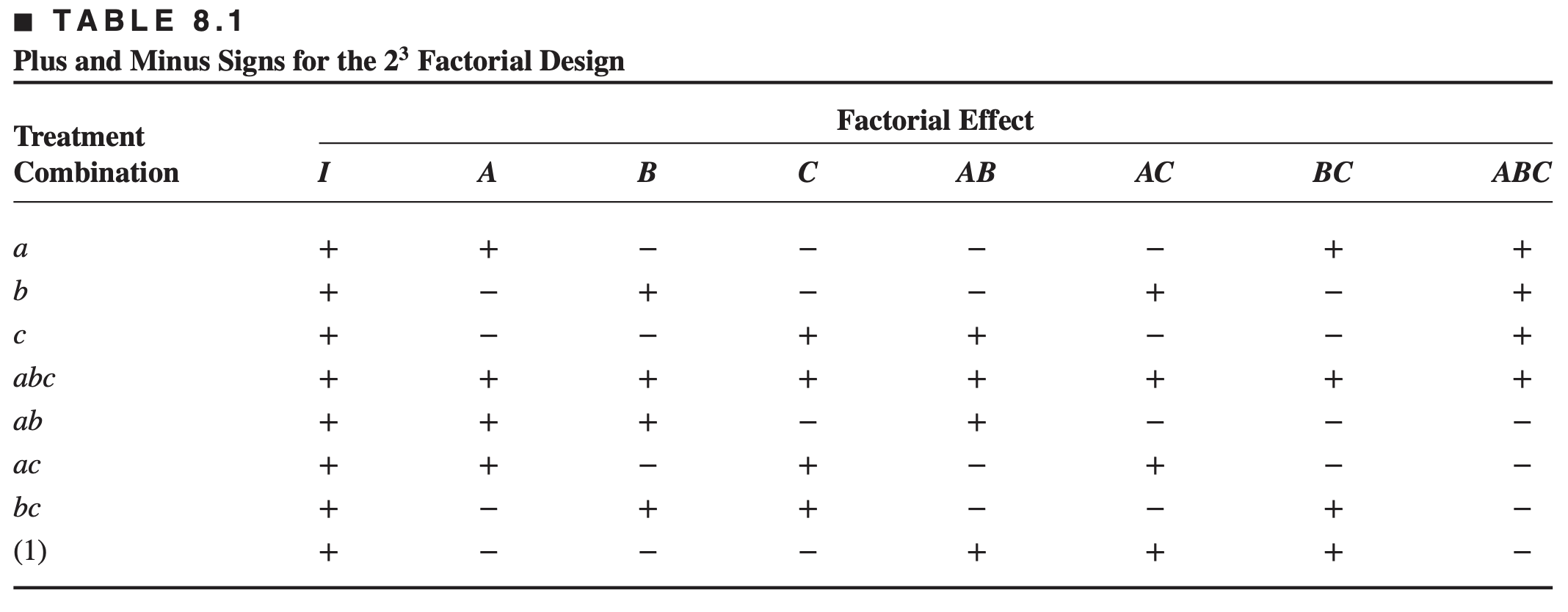
For the principal fraction, notice that the contrast for
The estimates of the main effects of
The estimates of the interactions
Thus,
In fact, when we estimate
In our example,
We indicate this by the notation
The alias structure for this design may be easily determined by using the defining relation
Multiplying any column (or effect) by the defining relation yields the aliases for that column (or effect).
In our example, this yields that the alias of
Similarly, we find that (
This one-half fraction, with
The other one-half fraction, that is, the treatment combinations associated with minus in the
The defining relation for this design is
The alternate fraction gives us
Thus, when we estimate
In practice, it does not matter which fraction is actually used. The two one-half fractions form a complete
Suppose that after running one of the one-half fractions of the
We may now obtain de-aliased estimates of all the effects by analyzing the eight runs as a full
This could also be done by adding and subtracting the linear combination of effects from the two individual fractions.
Thus, for all three pairs of linear combinations, we would obtain the following:

Furthermore, by assembling the full
Design resolution
The preceding
In such a design, main effects are aliased with two-factor interactions.
A design is of resolution
if no -factor effect is aliased with another effect containing less than factors
We usually employ a Roman numeral subscript to denote design resolution;
Thus, the one-half fraction of the
Design resolutions describe how much the effects in a fractional factorial design are aliased with other effects.
When we do a fractional factorial design, one or more of the effects are confounded, meaning they cannot be estimated separately from each other.
Usually, we want to use a fractional factorial design with the highest possible resolution.
Resolution III designs.
These are designs in which no main effects are aliased with any other main effect, but main effects are aliased with two-factor interactions and some two-factor interactions may be aliased with each other.
The
Resolution IV design.
These are designs in which no main effect is aliased with any other main effect or with any two-factor interaction, but two-factor interactions are aliased with each other.
A
Resolution V design.
These are designs in which no main effect or two-factor interaction is aliased with any other main effect or two-factor interaction, but two-factor interactions are aliased with three-factor interactions.
A
- In general, the resolution of a two-level fractional factorial design is equal to the shortest number of letters in any word in the defining relation
Higher the resolution better the design (why?)
We never want a resolution II design, because a design would alias two main effects. Thus minimum acceptable resolution in III.
Resolution III designs have some main effects aliased to two-factor interactions. If we believe that only main effects are present and all interactions are negligible, then a resolution III design is sufficient for estimating main effects.
Resolution III designs are called main effects design for this reason.
If we believe that some two factor interactions may be non negligible but all three way and higher interactions are negligible then a resolution IV is sufficient for main effects.
Low resolution fractional factorials are often used as screening designs, where we are trying to screen many factors to see if any of them has an effect. This is usually an early stage of investigation.
Construction and Analysis of the One-Half Fraction
A one-half fraction of the
writing down a basic design consisting of the runs for a full
then adding the the
Constructing one-half fractions
- E.g. the

Note that any interaction effect could be used to generate the column for the
However, using any effect other than
Another way to view the construction of a one-half fraction is to partition the runs into two blocks with the highest order interaction
Sequences of fractional factorials
Fractional factorial designs could be less expensive and efficient in experimentation, if the runs can be made sequentially
If the interest is in investigating
If necessary we can always run the alternate fraction and get the complete
Projection of Fractions into Factorials
Any fractional factorial design of resolution
contains complete factorial designs (possibly replicated factorials) in any subset of factors.
This is an important and useful concept
Because the maximum possible resolution of a one-half fraction of the
Furthermore, a
EXAMPLE 8.1
Consider the filtration rate experiment in Example 6.2. The original design is a single replicate of the
In that example, we found that the main effects
We will now return to this experiment and simulate what would have happened if a half-fraction of the
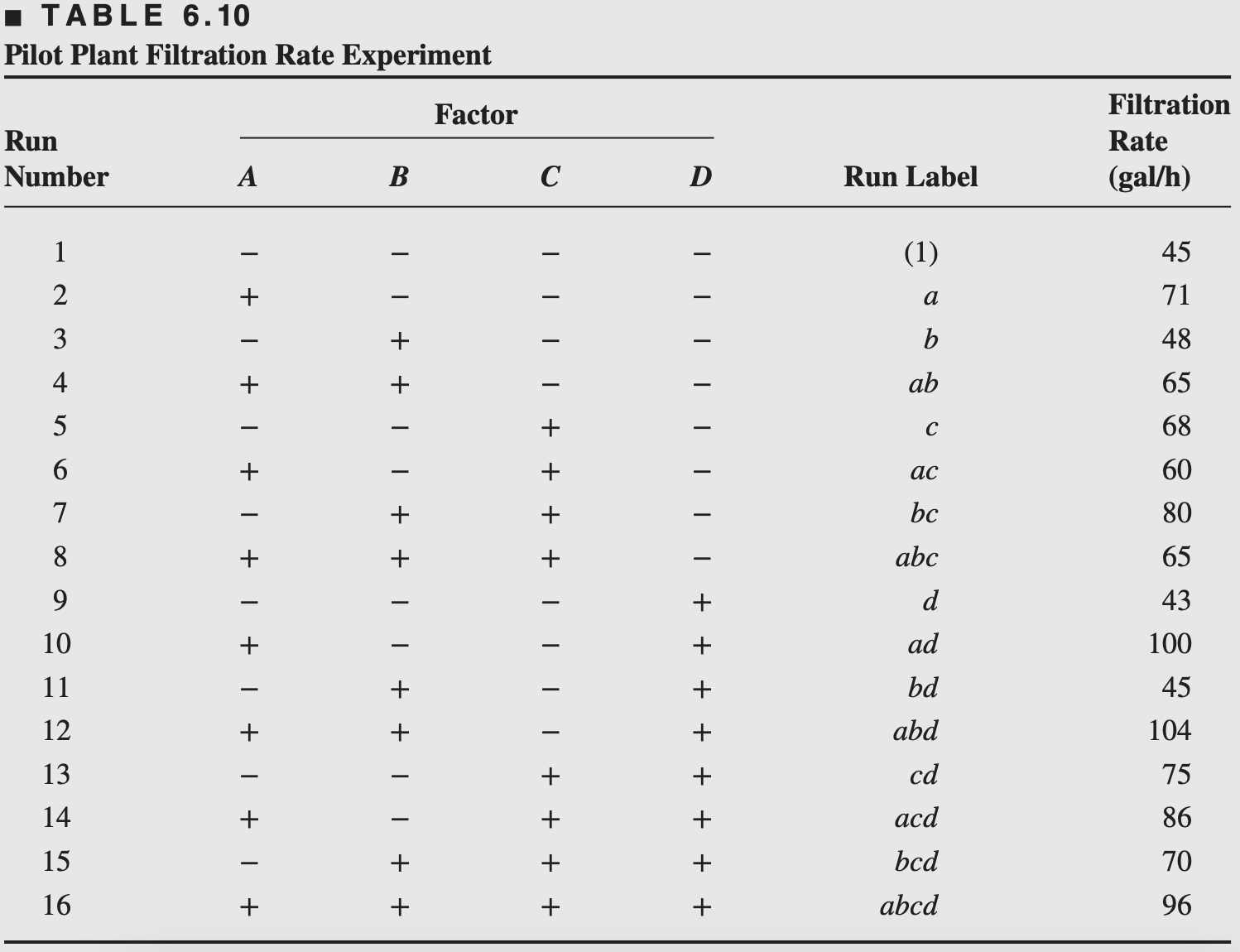
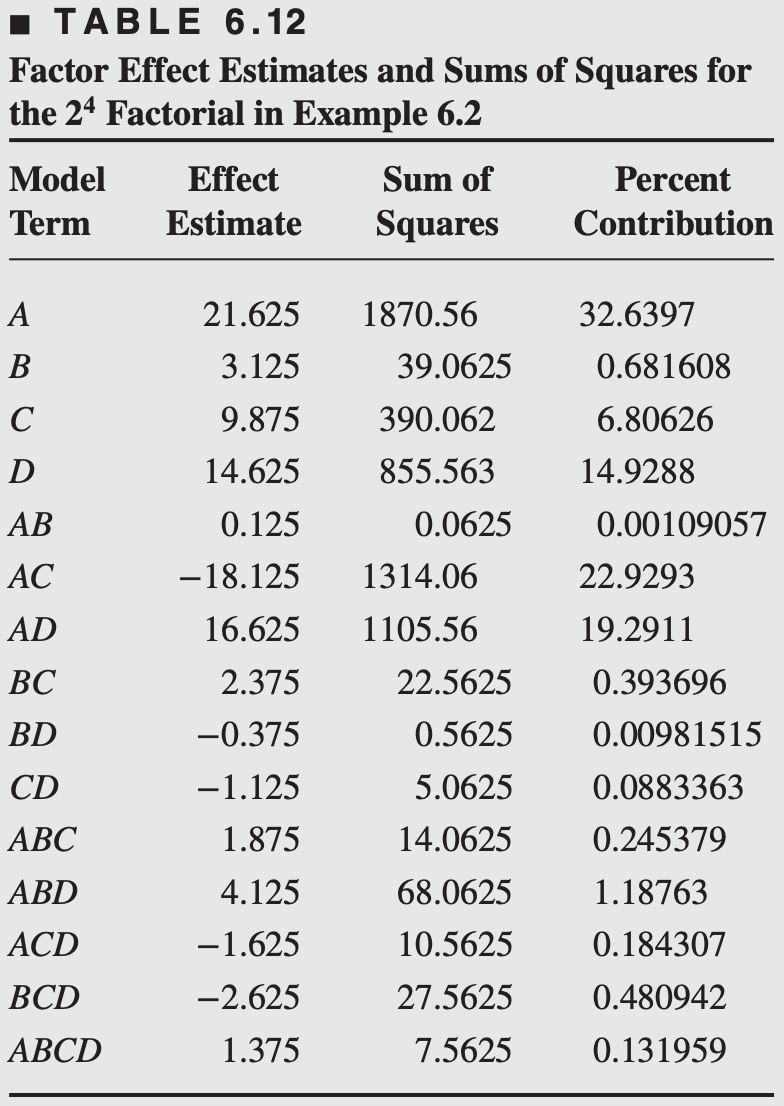
We will use the
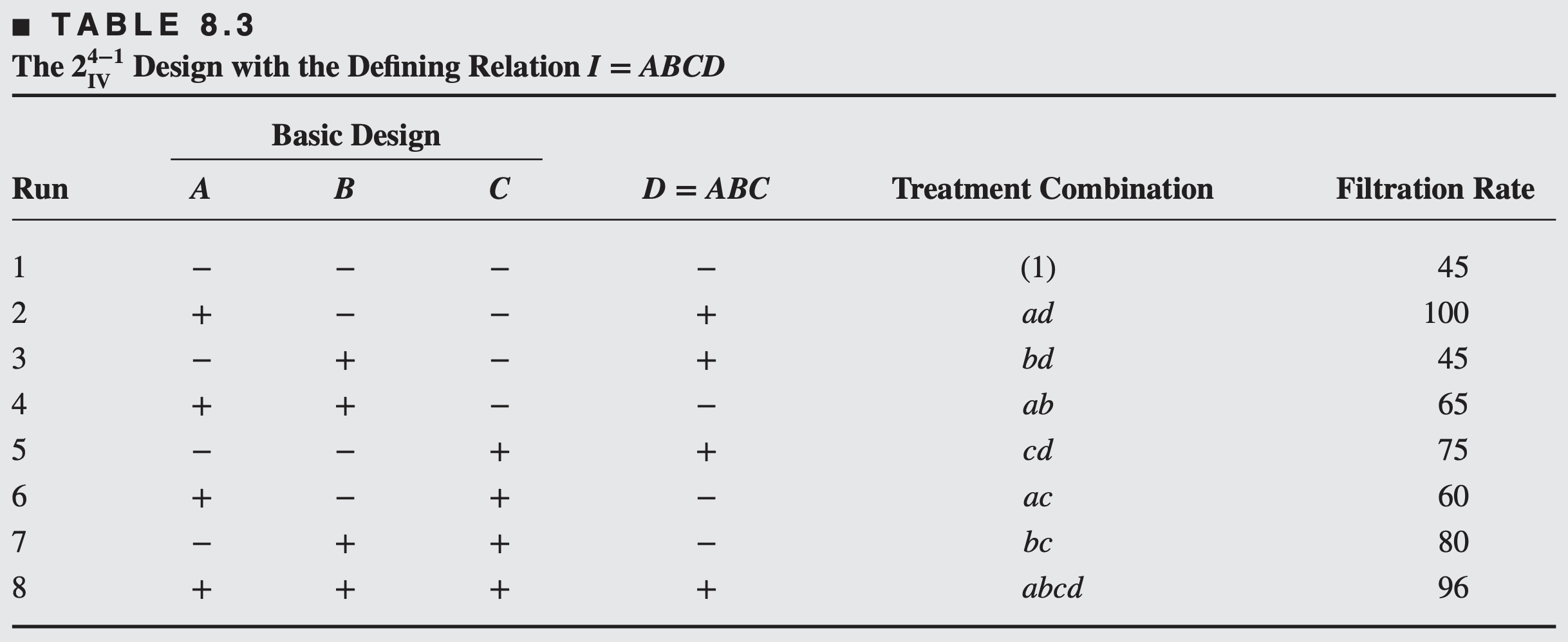
Using the defining relation, we note that each main effect is aliased with a three-factor interaction; that is,
Furthermore, every two-factor interaction is aliased with another two-factor interaction. These alias relationships are
The four main effects plus the three two-factor interaction alias pairs account for the seven degrees of freedom for the design.
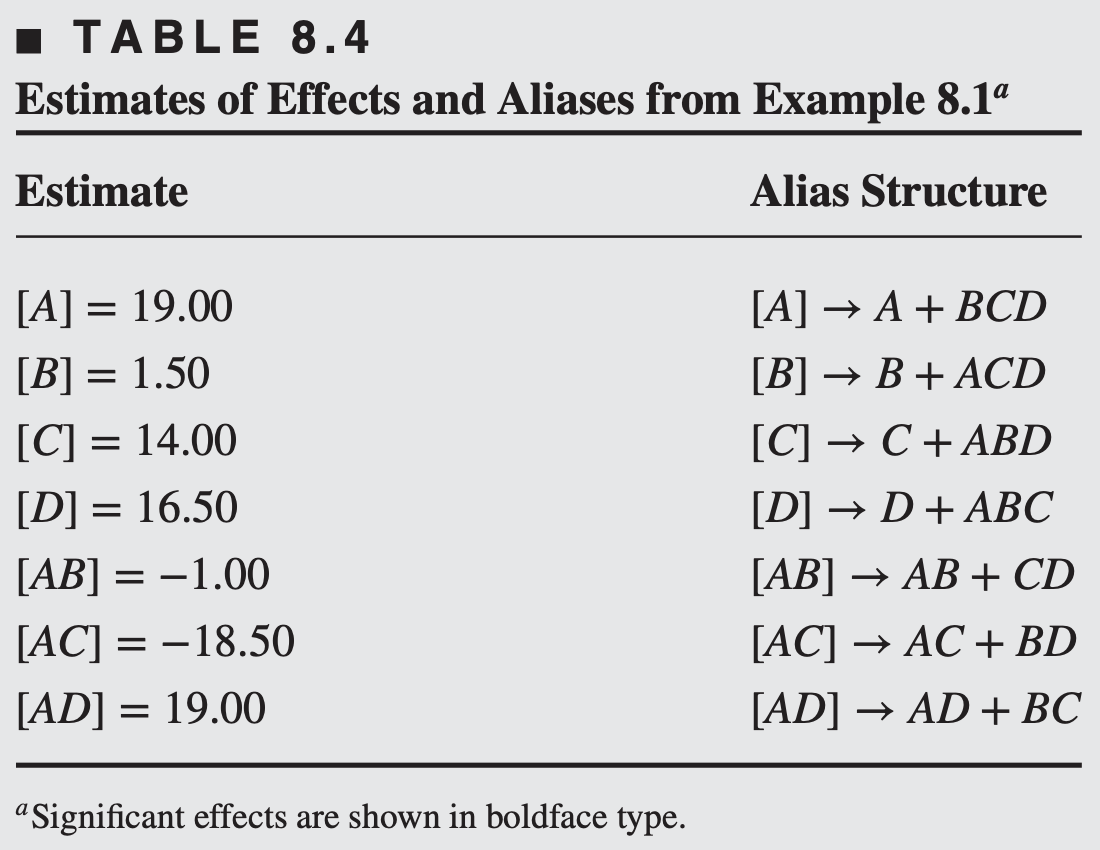
Because factor B is not significant, we may drop it from consideration. Consequently, we may project this design into a single replicate of the
Based on the above analysis, we can now obtain a model to predict filtration rate over the experimental region. This model is
There are two large effects associated with two-factor interactions,
In Example
However, we can always isolate the significant interaction by running the alternate fraction, given by
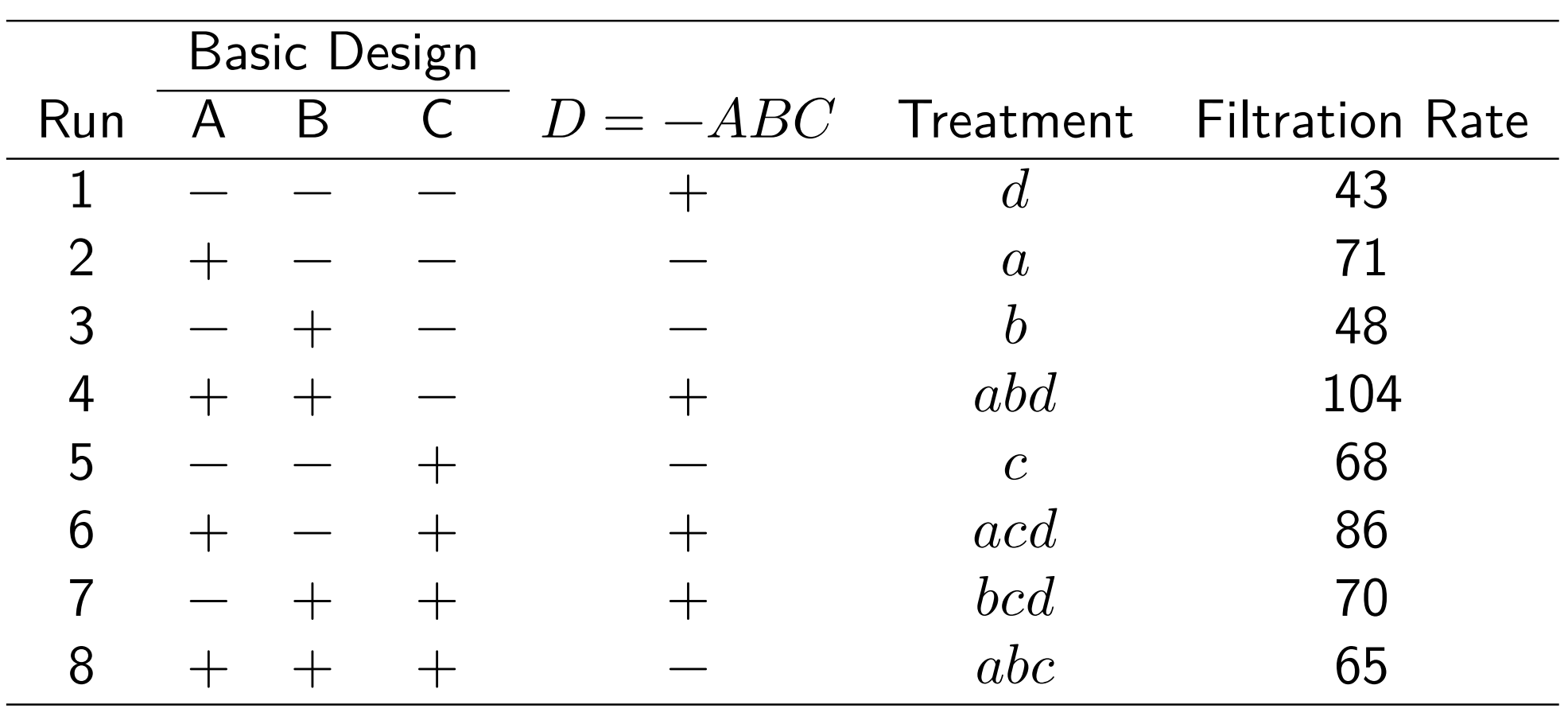

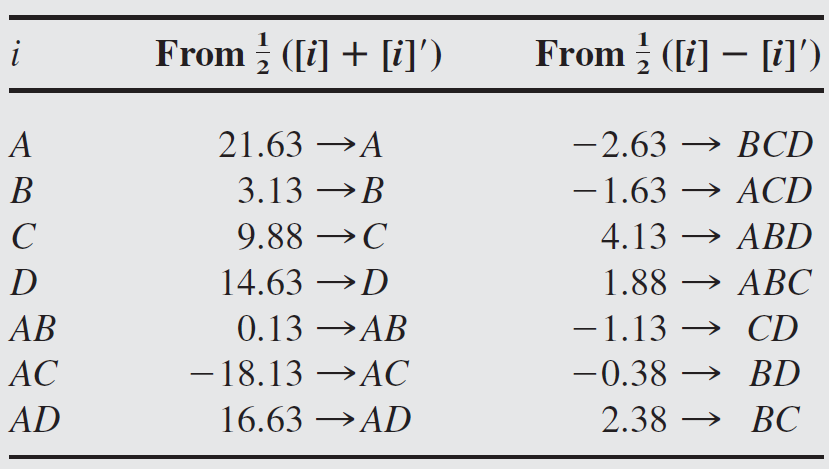
8.3 The one-quarter fraction of the
One-quarter fraction of the
This design contains
The construction of the
The one-quarter fraction of the
Complete defining relation is
As an example, consider
The complete defining relation for this design is
This
For the
When we estimate the main effect of
Similarly, when we estimate 2-factor interaction
The complete alias structure of this design is
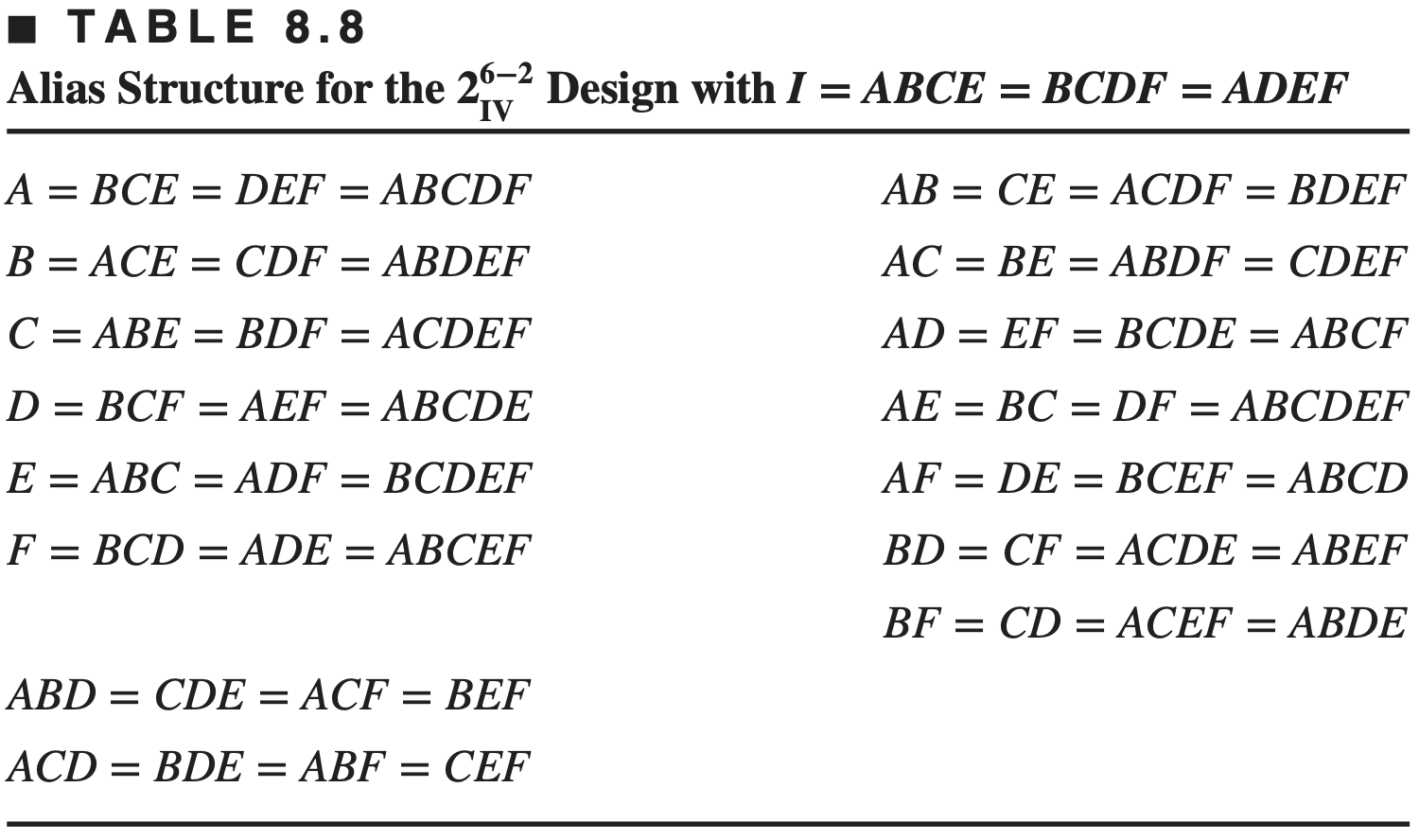
To construct the design, first write down the basic design, which consists of the 16 runs for a full
Then the two factors
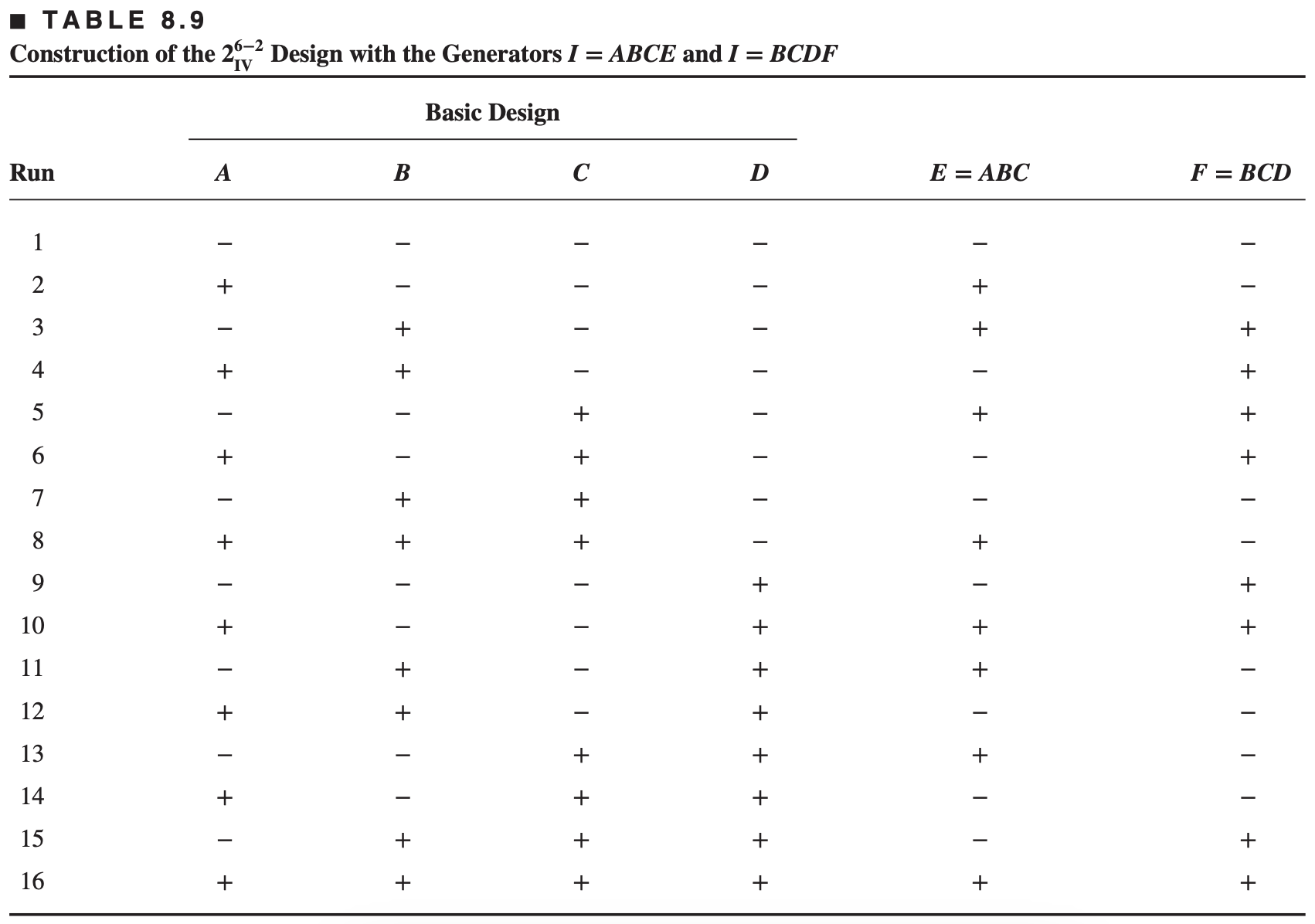
Another way to construct this design is to derive the four blocks of the
This would be a
- For this
EXAMPLE 8.4
A quality improvement team has decided to use a designed experiment to study the injection molding process so that shrinkage can be reduced. The team decides to investigate six factors Mold temperature (
The objective of this experiment is of learning how each factor affects shrinkage and also, something about how the factors interact. The team decides to use the 16-run two-level fractional factorial design.
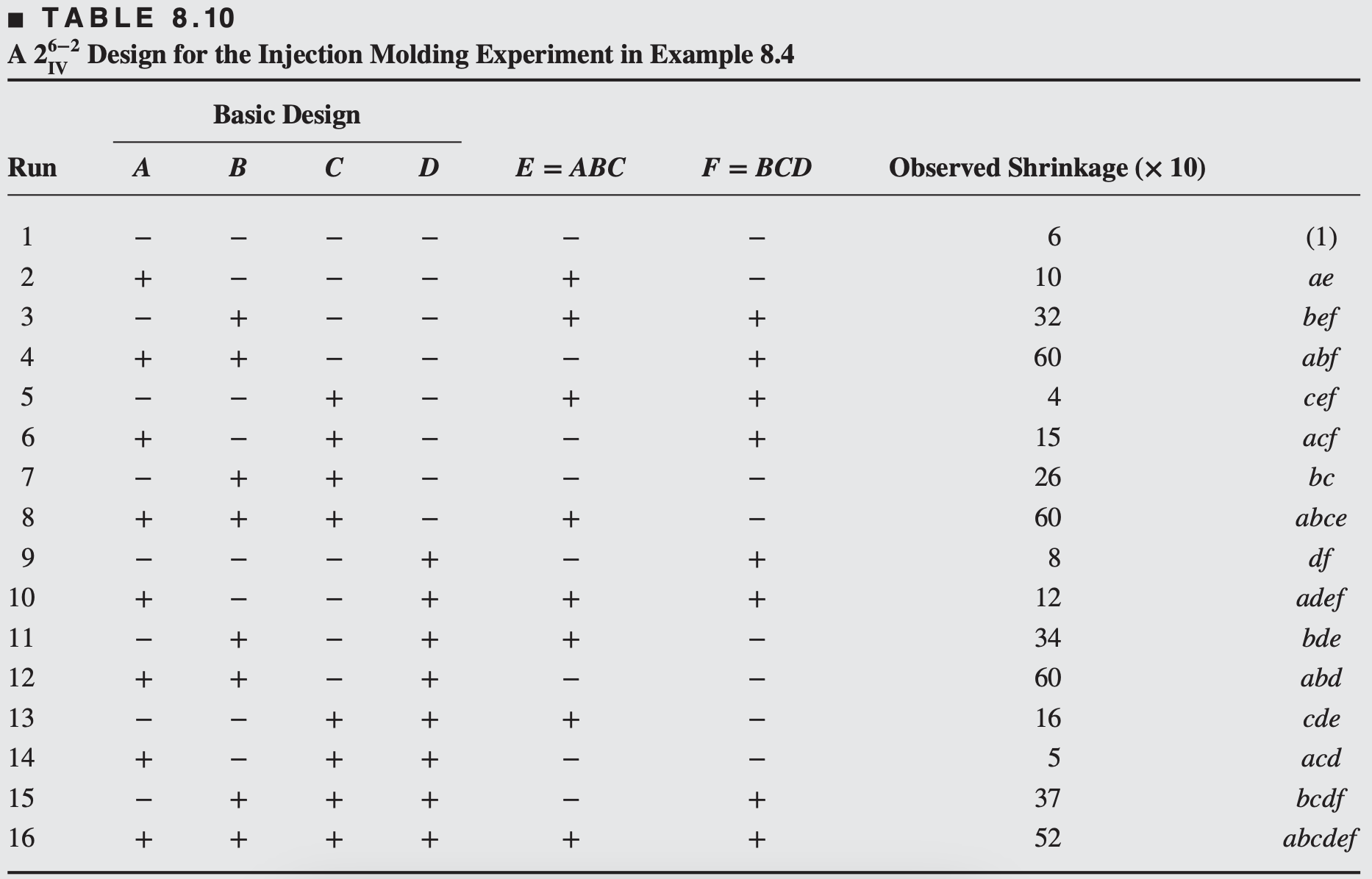
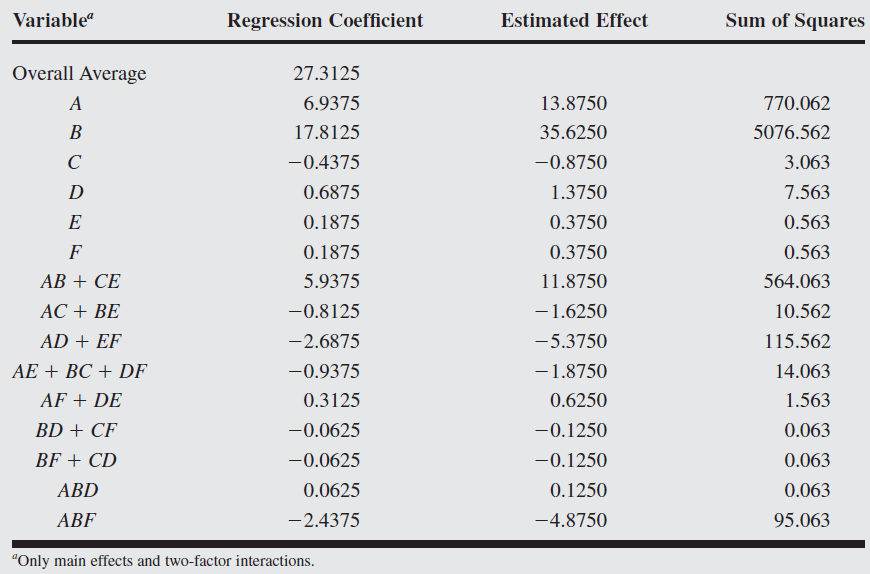
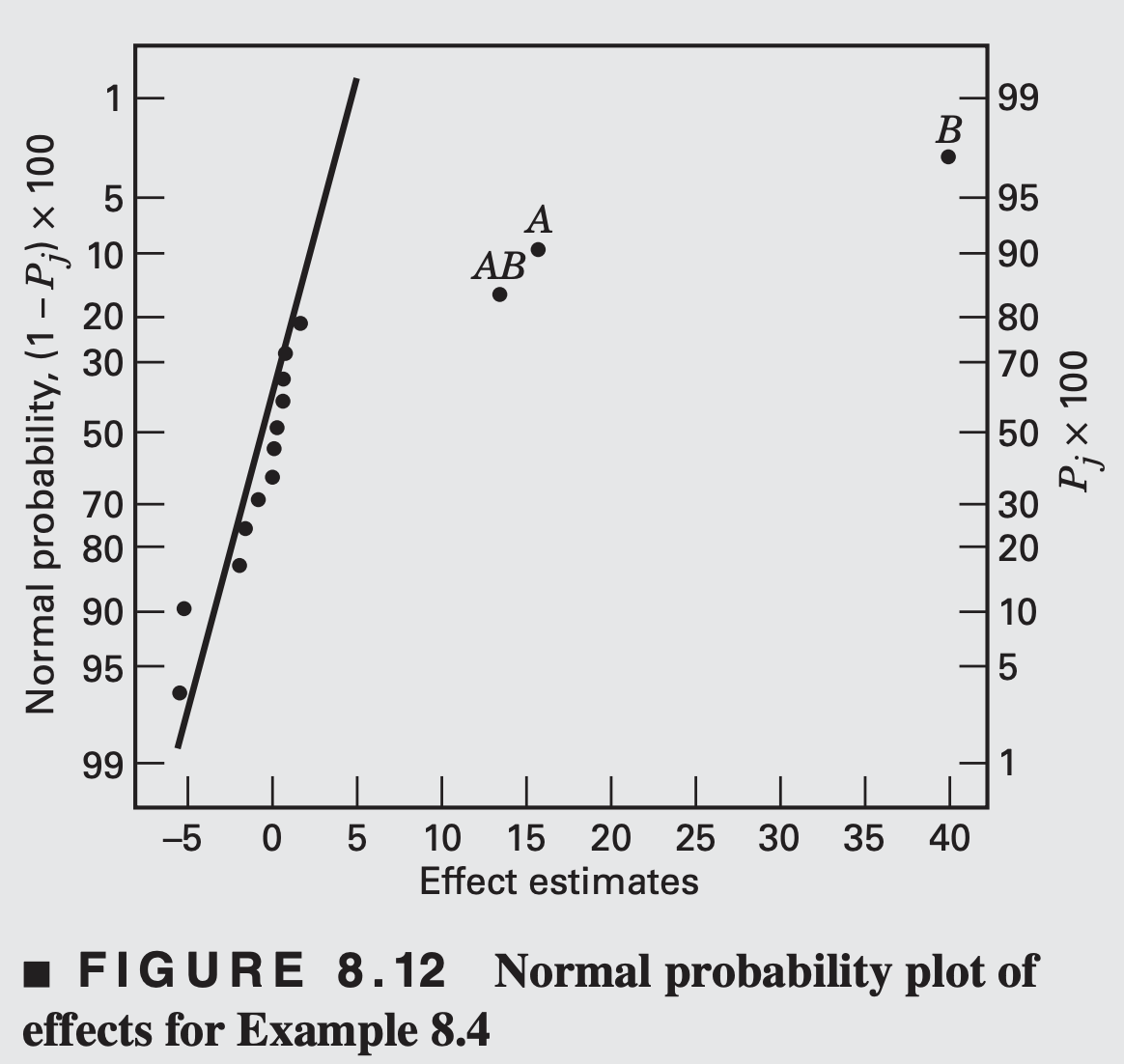
The only large effects are A (mold temperature), B (screw speed), and the AB interaction
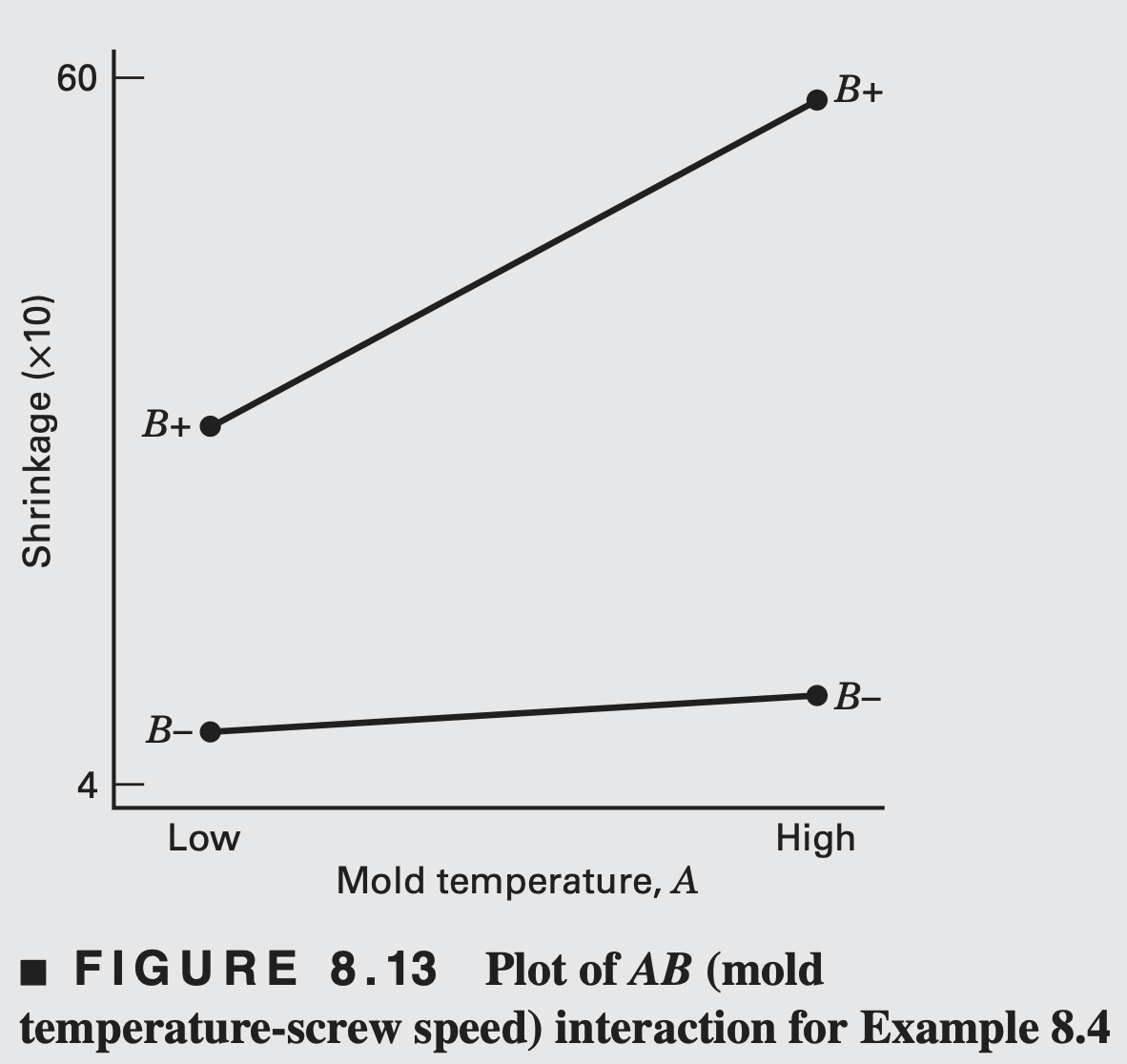
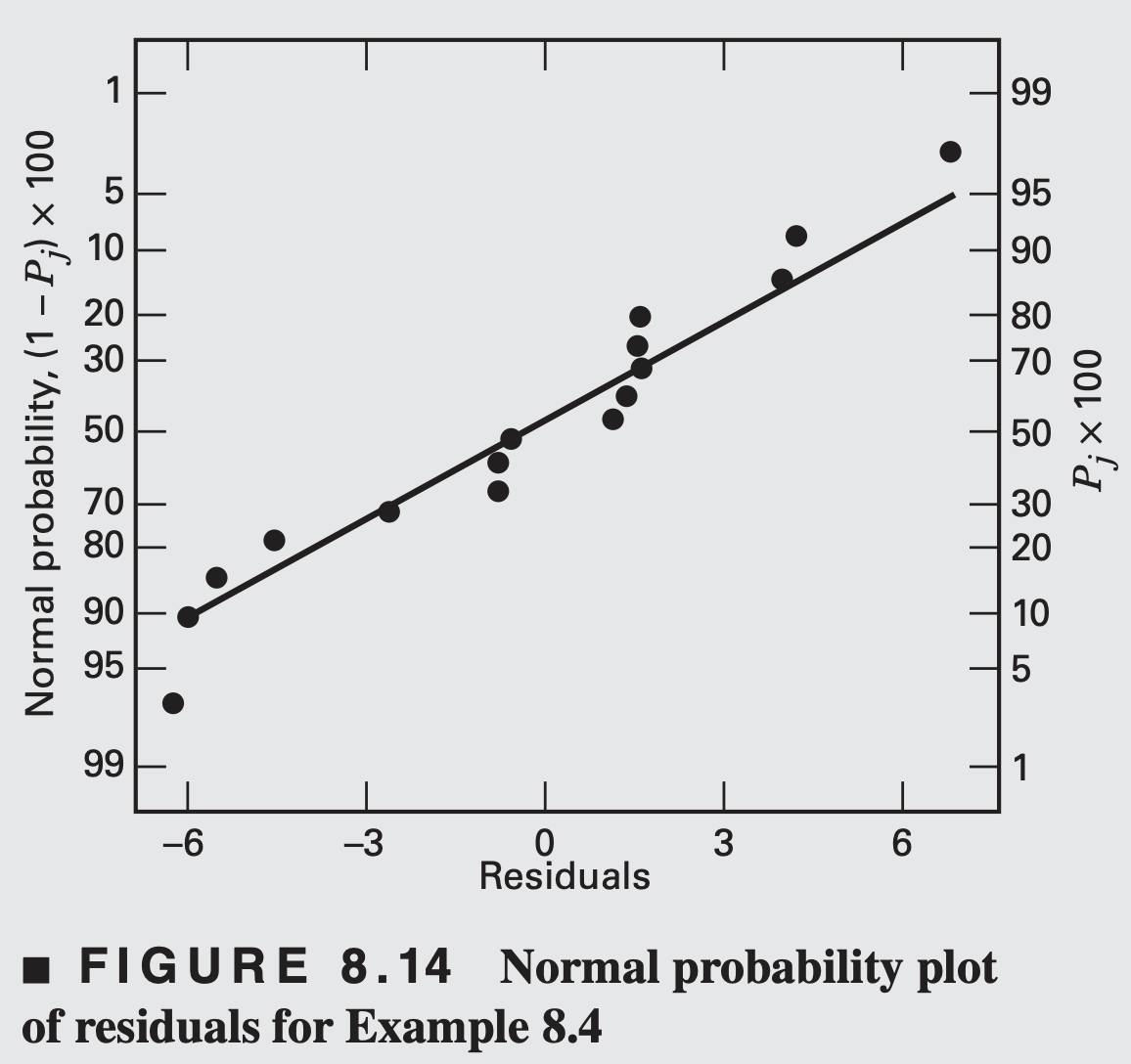
The plot of the AB interaction shows that the process is very insensitive to temperature if the screw speed is at the low level but very sensitive to temperature if the screw speed is at the high level.
Based on this initial analysis, the team decides to set both the mold temperature and the screw speed at the low level
8.4 The general
A
These designs require the selection of
The alias structure can be found by multiplying each effect column by the defining relation and generators should be chosen carefully so that effects of potential interest are not aliased with each other, and each effect will have
For moderately large values of
It is important to select the
A reasonable criterion is to select the generators such that the resulting
Defining relation
Defining relation
Sometimes resolution alone is insufficient to distinguish between designs. For example, consider the three
Sometimes resolution alone is insufficient to distinguish between designs. consider the three
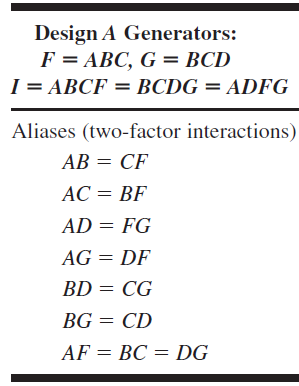
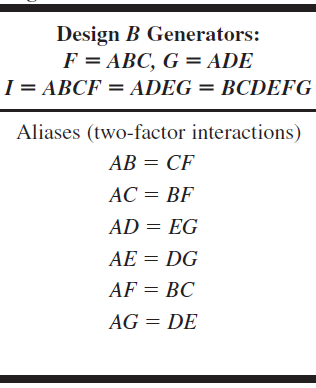
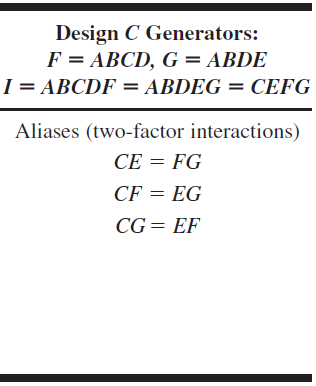
All of these designs are of resolution IV, but they have rather different alias structures (we have assumed that three-factor and higher interactions are negligible) with respect to the two-factor interactions.
Clearly, design A has more extensive aliasing and design
The three word lengths in design A are all 4; that is, the word length pattern is
For design
Notice that the defining relation for design
Thus, design
Minimizing aberration in a design of resolution
Table
The suggested generators in this table will result in a design of the highest possible resolution. These are also the minimum aberration designs.
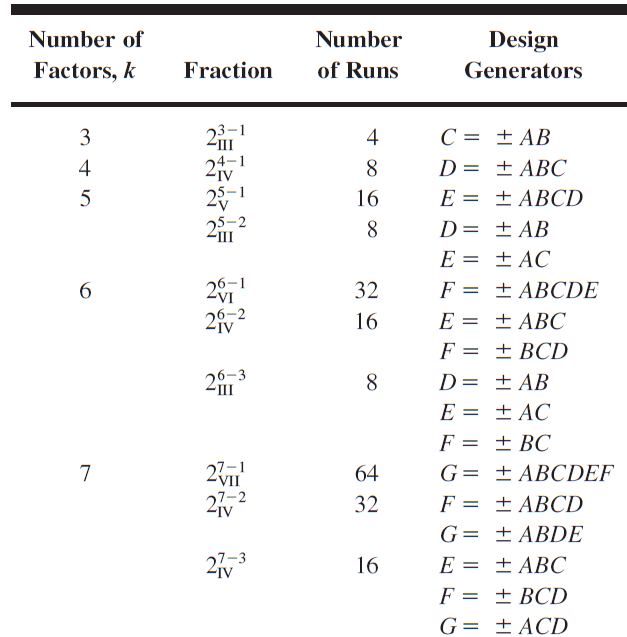
The alias relationships for all of the designs in Table
The alias relationships presented in this table focus on main effects and two- and three-factor interactions. The complete defining relation is given for each design.
This appendix table makes it very easy to select a design of sufficient resolution to ensure that any interactions of potential interest can be estimated.
Analysis of
The
The
Exercise 8.12.
An article in Industrial and Engineering Chemistry (“More on Planning Experiments to Increase Research Efficiency,” 1970, pp. 60-65) uses a
Verify that the design generators used were I
Write down the complete defining relation and the aliases for this design.
Estimate the main effects.
Prepare an analysis of variance table. Verify that the AB and AD interactions are available to use as error.
Plot the residuals versus the fitted values. Comment on the results.
8.4.3 Blocking Fractional Factorials
Occasionally, a fractional factorial design requires so many runs that all of them cannot be made under homogeneous conditions.
In these situations, fractional factorials may be confounded in blocks.
Appendix Table X contains recommended blocking arrangements for many of the fractional factorial designs in Table 8.14. The minimum block size for these designs is eight runs
In assigning fractional factorials into blocks, we need to be careful about the effects to be confounded with blocks
The
This fractional design contains 16 treatment combinations.
We want to conduct the experiment into two blocks. Which effect should we select to be confounded with blocks?
- In selecting an interaction to confound with blocks, we note from examining the alias structure in Appendix Table IX(f) that there are two alias sets involving only three-factor interactions.
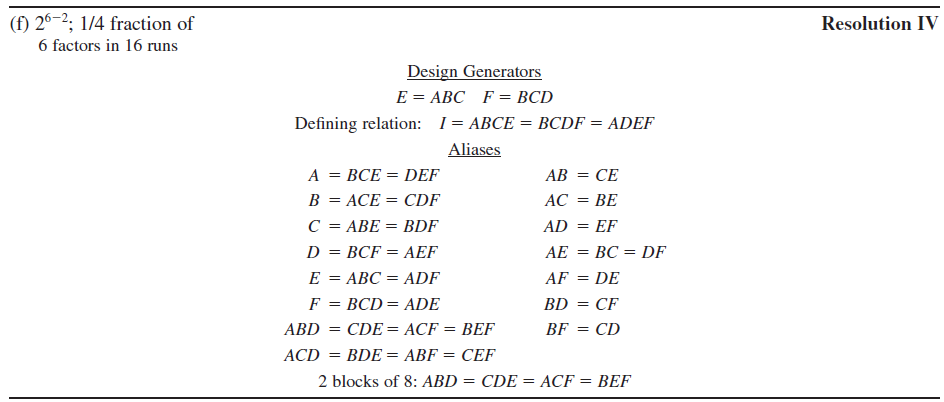
- The table suggests selecting ABD (and its aliases) to be confounded with blocks.
- Assume the effect
Block-1
Block-2
- Notice that the principal block contains those treatment combinations that have an even number of letters in common with ABD.
Example 8.6
A five-axis CNC machine is used to produce an impeller for a jet turbine engine. The blade profiles are an important quality characteristic.
Specifically, the deviation of the blade profile from the profile specified on the engineering drawing is of interest.
An experiment is run to determine which machine parameters affect profile deviation.
The eight factors selected for the design are as follows:
The profile deviation is measured using a coordinate measuring machine, and the standard deviation of the difference between the actual profile and the specified profile is used as the response variable.
The machine has four spindles. Because there may be differences in the spindles, the process engineers feel that the spindles should be treated as blocks.
The engineers feel confident that three-factor and higher interactions are not too important, but they are reluctant to ignore the two-factor interactions.
From Table 8.14, two designs initially appear appropriate: the
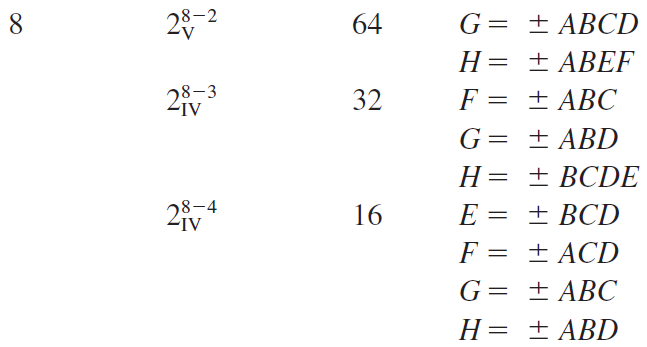
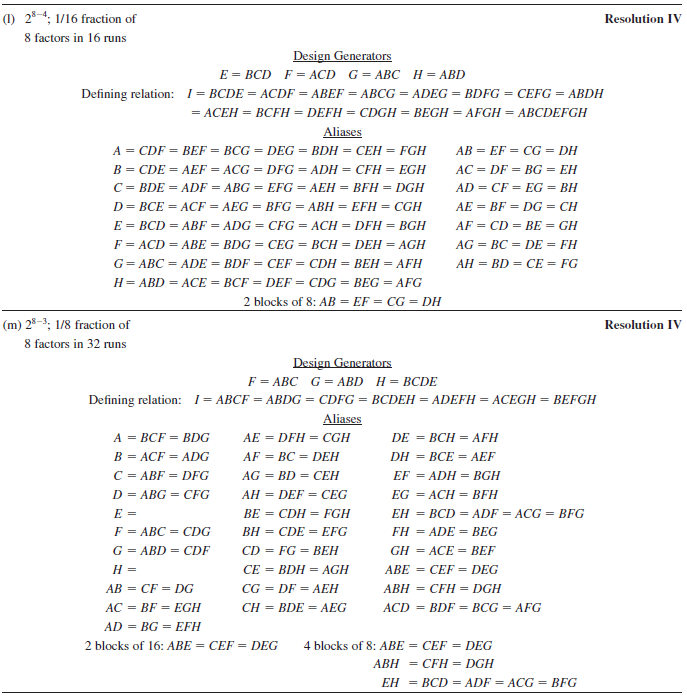
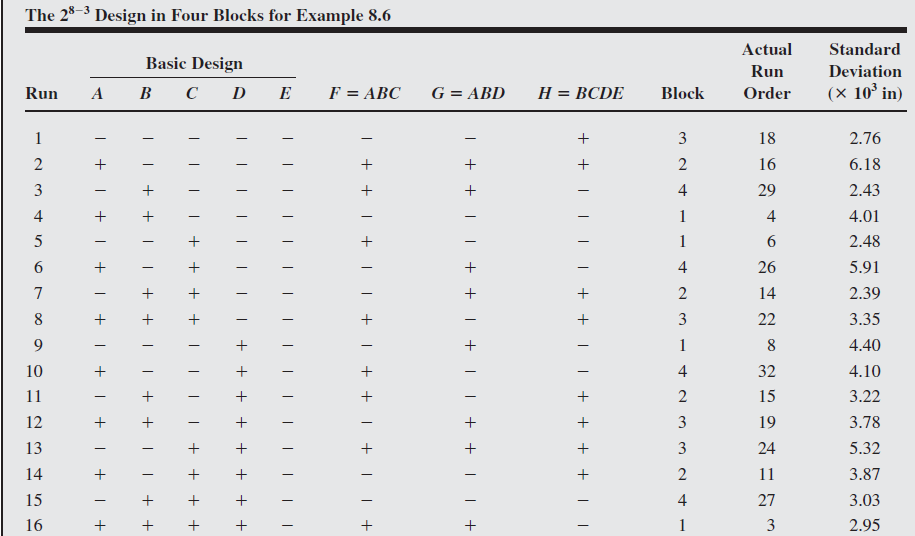

Because the response variable is a standard deviation, it is often best to perform the analysis following a log transformation.
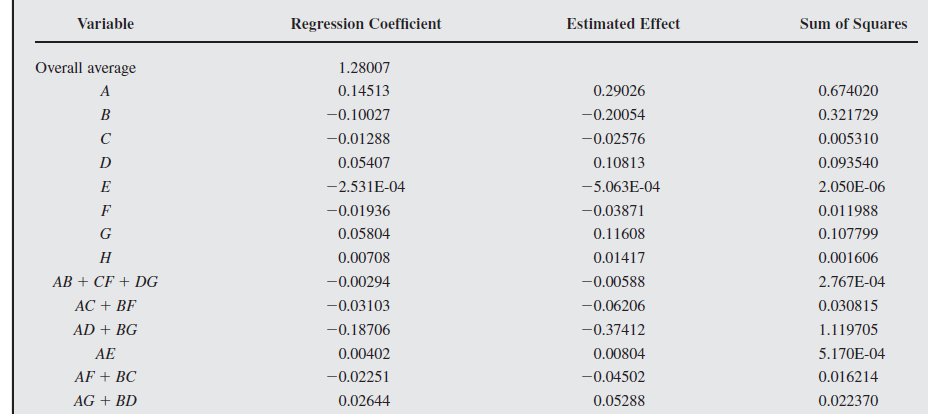

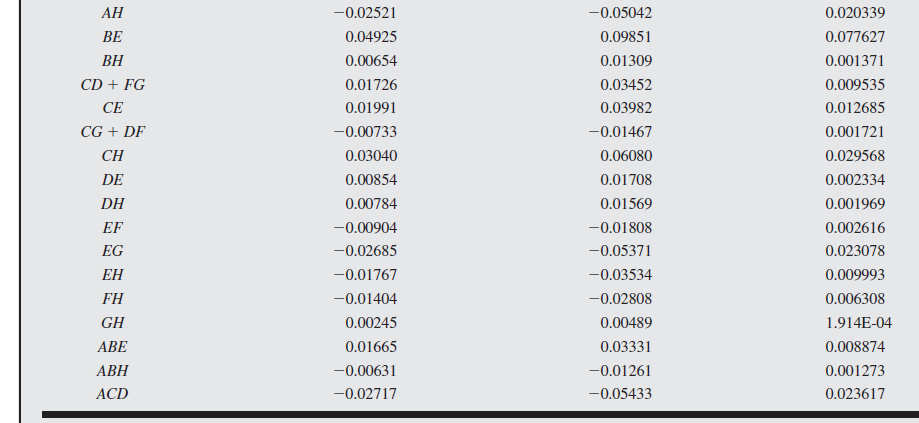
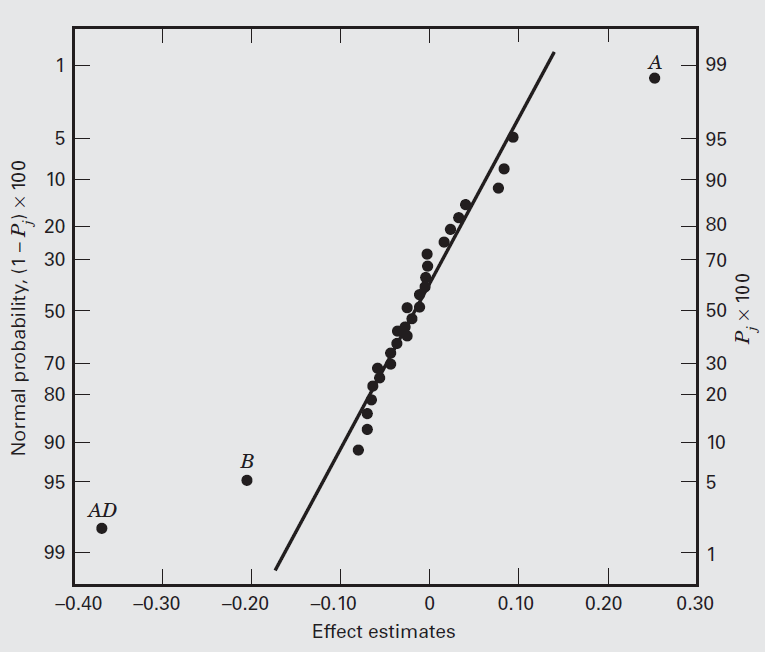
Suppose that process knowledge suggests that the appropriate interaction is likely to be
Following table shows the resulting analysis of variance for the model with factors
Notice that the block effect is small, suggesting that the machine spindles are not very different.
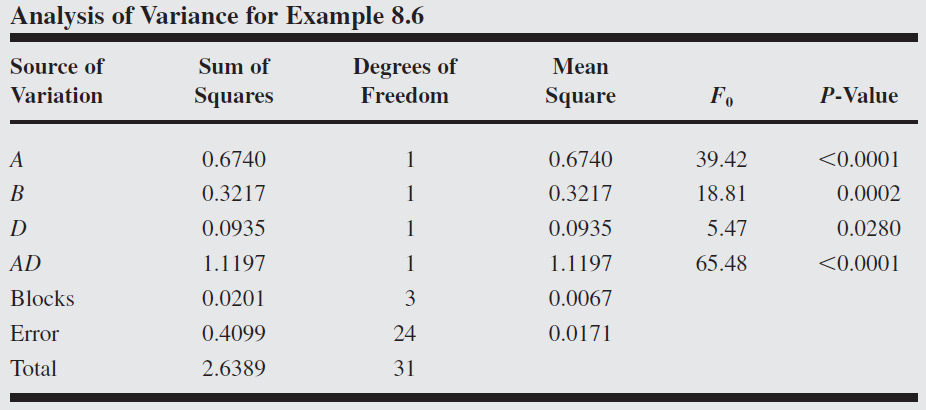
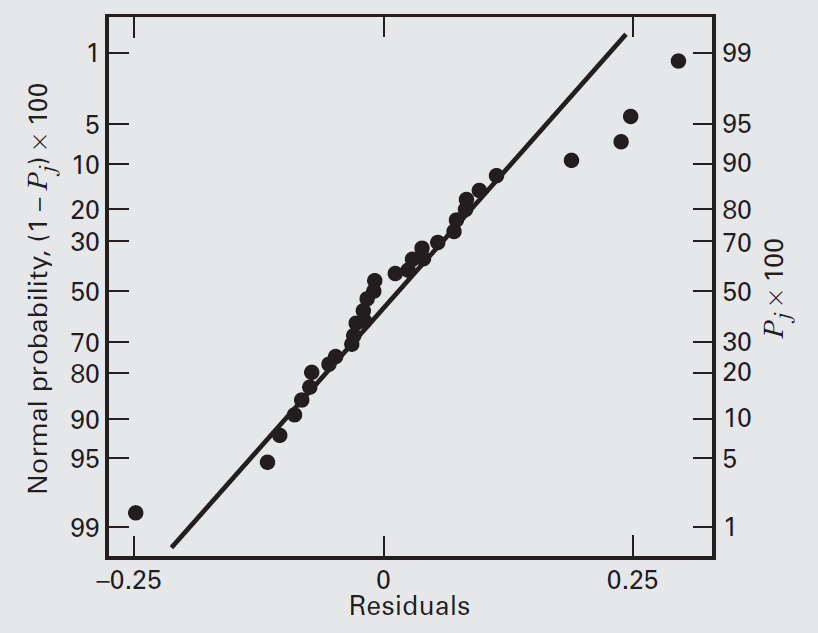
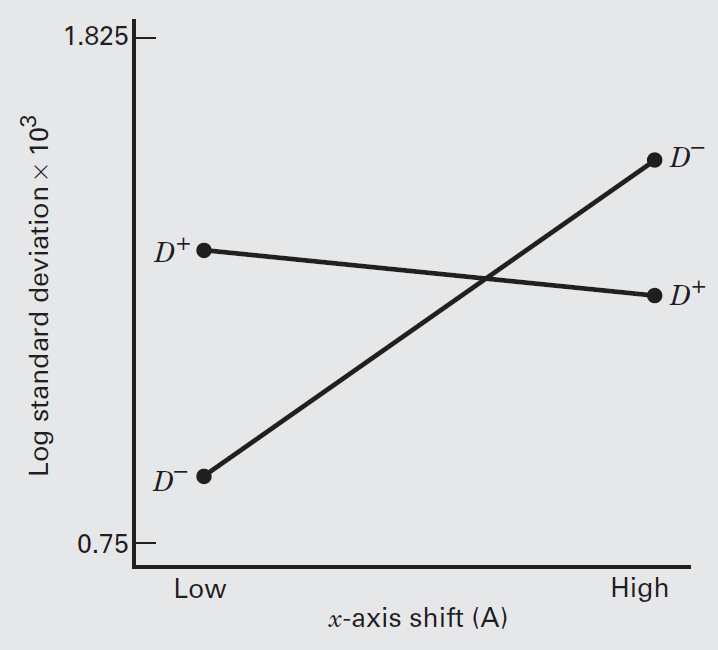
Normal probability plot of the residuals is suggestive of slightly heavier than normal tails, so possibly other transformations should be considered.
The
The projection of this design into four replicates of a
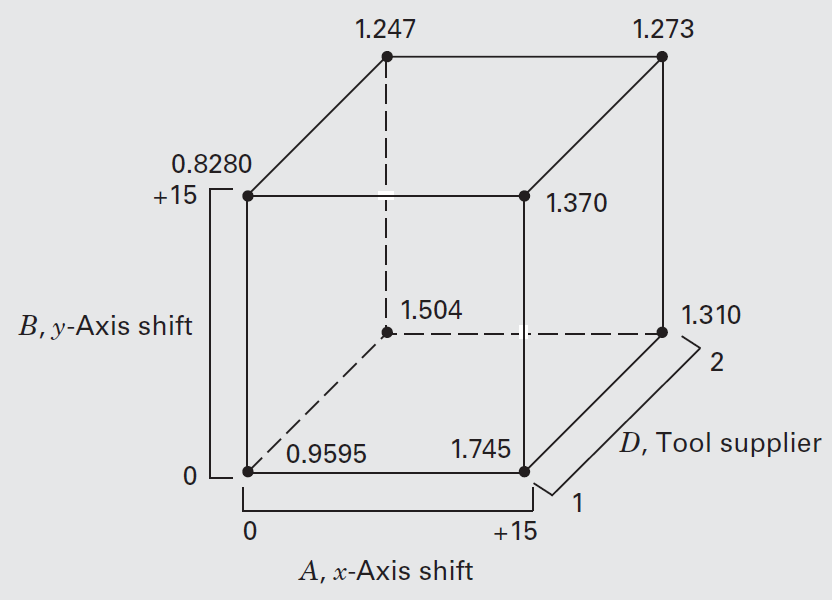
The figure indicates that the best combination of operating conditions is
Exercise 8.45
Consider the design:
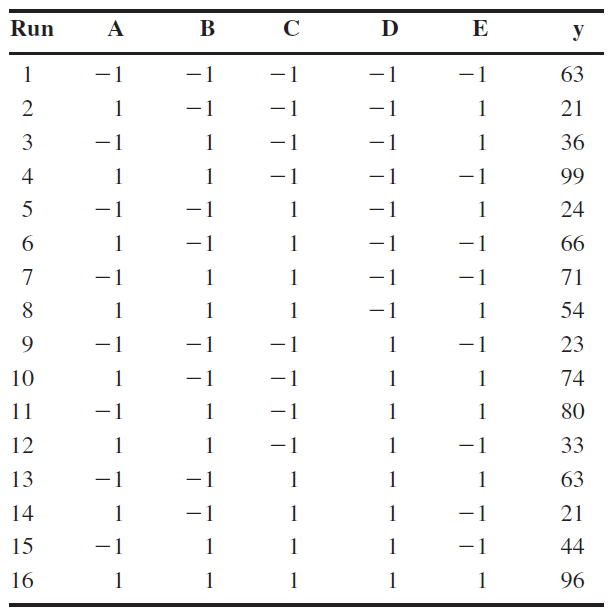
- What is the generator for column
- If
- What is the resolution of this design?
- Find the estimates of the main effects and their aliases.
8.5 Alias Structures in Fractional Factorials and Other Designs
Alias Structures in General Fractionals
In this chapter, we show how to find the alias relationships in a
This method works well in simple designs, such as the regular fractions we use most frequently, but it does not work as well in more complex settings, such as some of the nonregular fractions and partial fold-over designs that we will discuss subsequently.
Furthermore, there are some fractional factorials that do not have defining relations, such as the Plackett-Burman designs in Section 8.6.3, so the defining relation method will not work for these types of designs at all.
Fortunately, there is a general method available that works satisfactorily in many situations.
The method uses the polynomial or regression model representation of the model, say
The least squares estimate of
Suppose that the true model is
It can be shown that
The matrix
The elements of this matrix operating on
We illustrate the application of this procedure with a familiar example. Suppose that we have conducted a
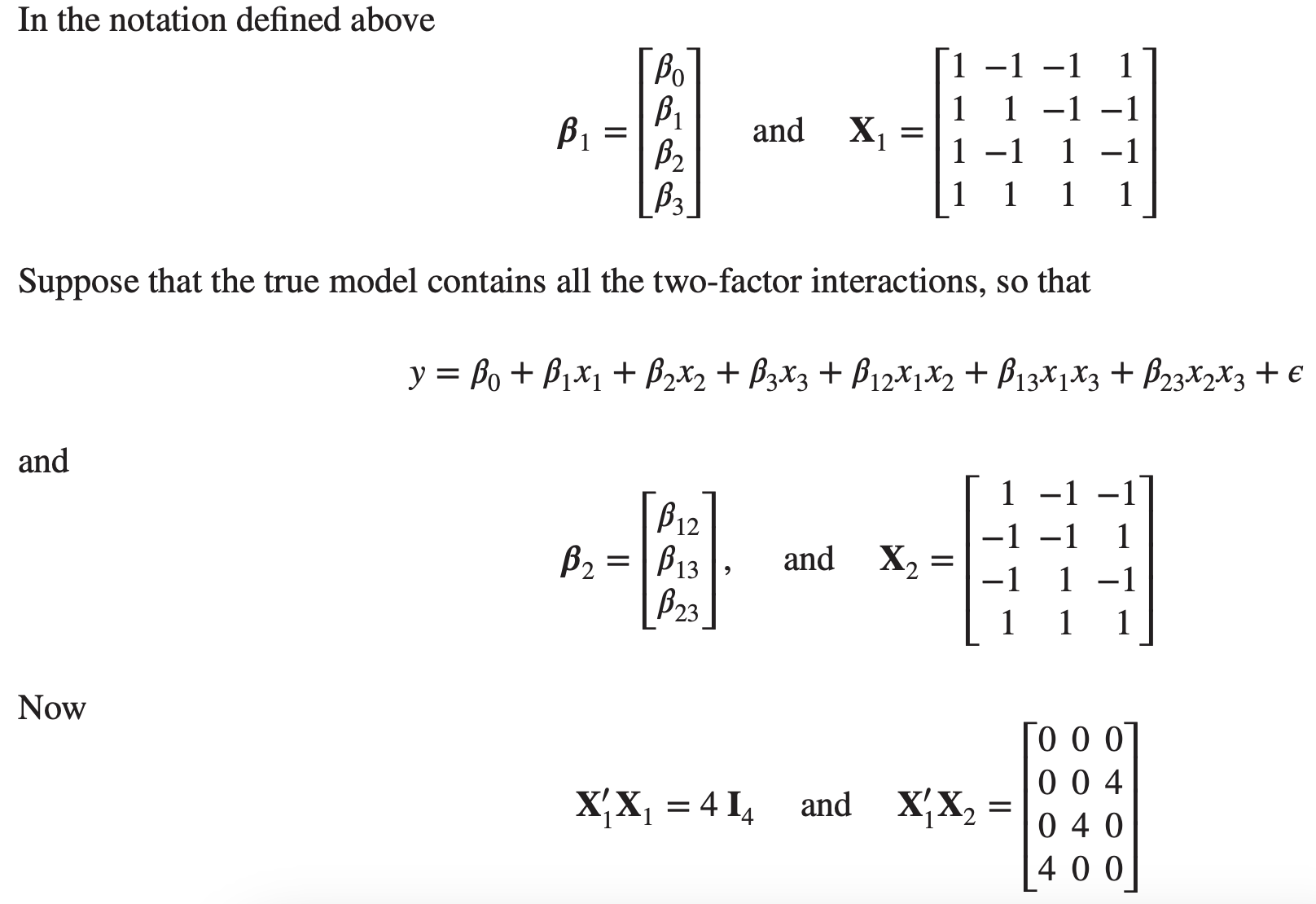
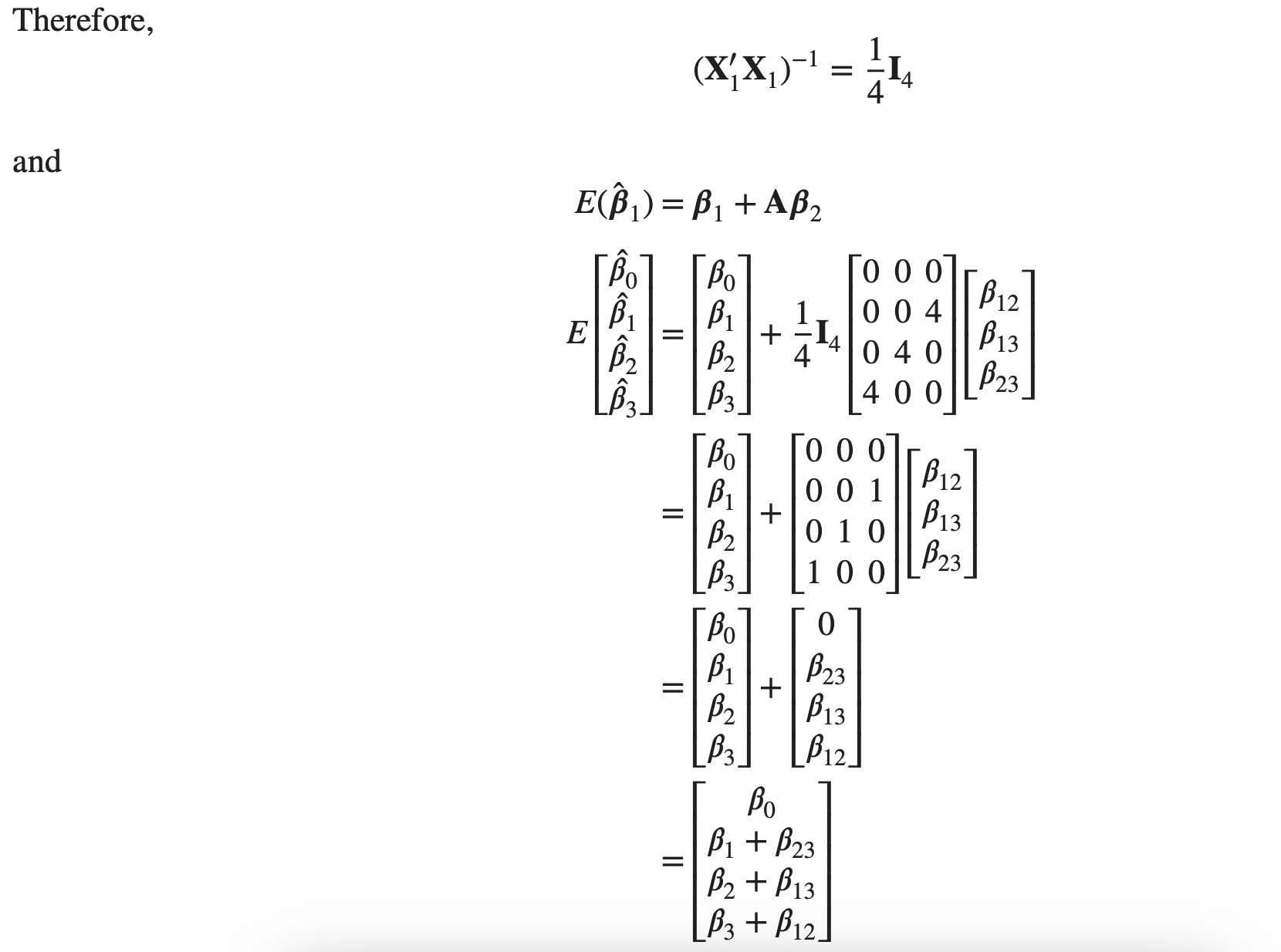
The interpretation of this is that each of the main effects is aliased with one of the two-factor interactions.
While this is a very simple example, the method is very general and can be applied to much more complex designs.
8.6 Resolution III Designs
The sequential use of fractional factorial designs is very useful, often leading to great economy and efficiency in experimentation.
This application of fractional factorials occurs frequently in situations of pure factor screening; that is, there are relatively many factors but only a few of them are expected to be important. Resolution III designs can be very useful in these situations.
It is possible to construct resolution III designs for investigating up to
These designs are frequently useful in industrial experimentation.
Important designs are 4 runs for up to 3 factors, 8 runs for up to 7 factors, and 16 runs for up to 15 factors.
If
A very useful saturated fractional factorial is a design for studying seven factors in eight runs, that is, the
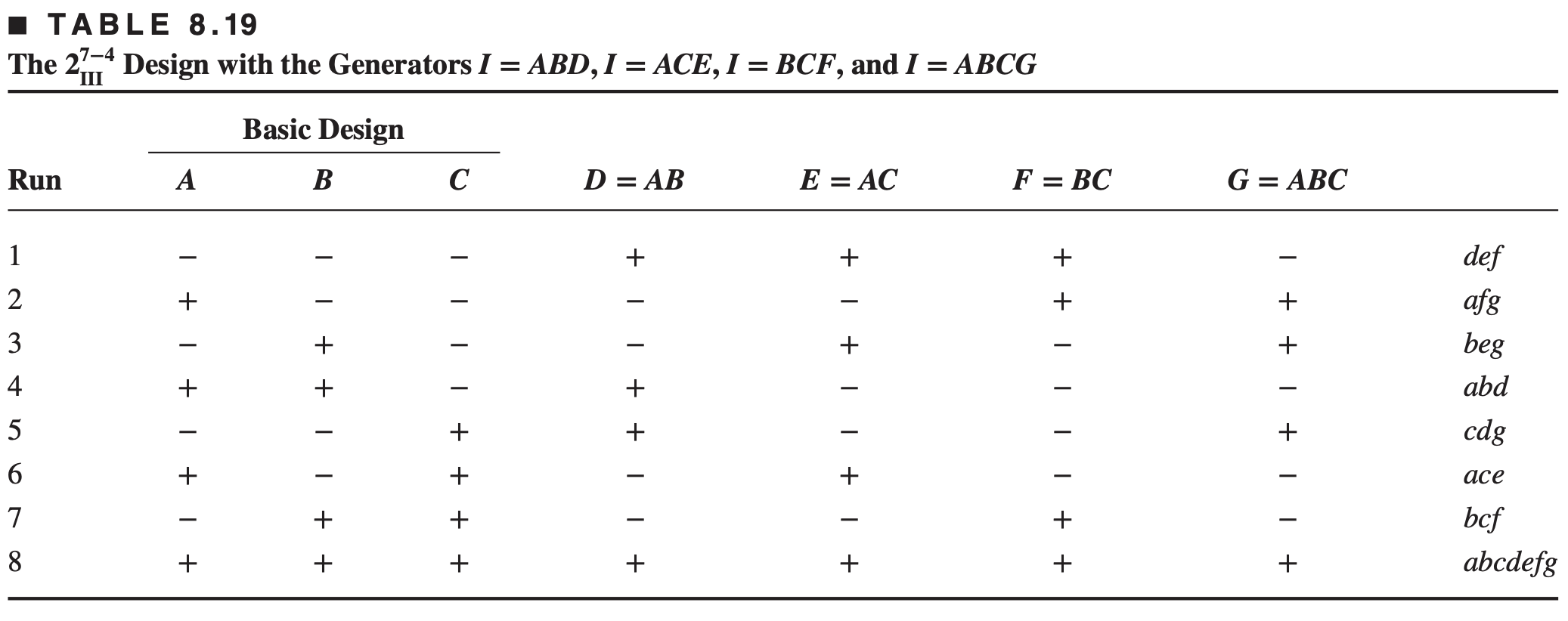
- The generators for this design are
The complete defining relation for this design is obtained by multiplying the four generators
To find the aliases of any effect, simply multiply the effect by each word in the defining relation. For example, the aliases of
This design is a one-sixteenth fraction, and because the signs chosen for the generators are positive, this is the principal fraction.
Any one of the 16 different
The seven degrees of freedom in this design may be used to estimate the seven main effects.
Each of these effects has 15 aliases; however, if we assume that three-factor and higher interactions are negligible, then considerable simplification in the alias structure results.
Making this assumption, each of the linear combinations associated with the seven main effects in this design actually estimates the main effect and three two-factor interactions:
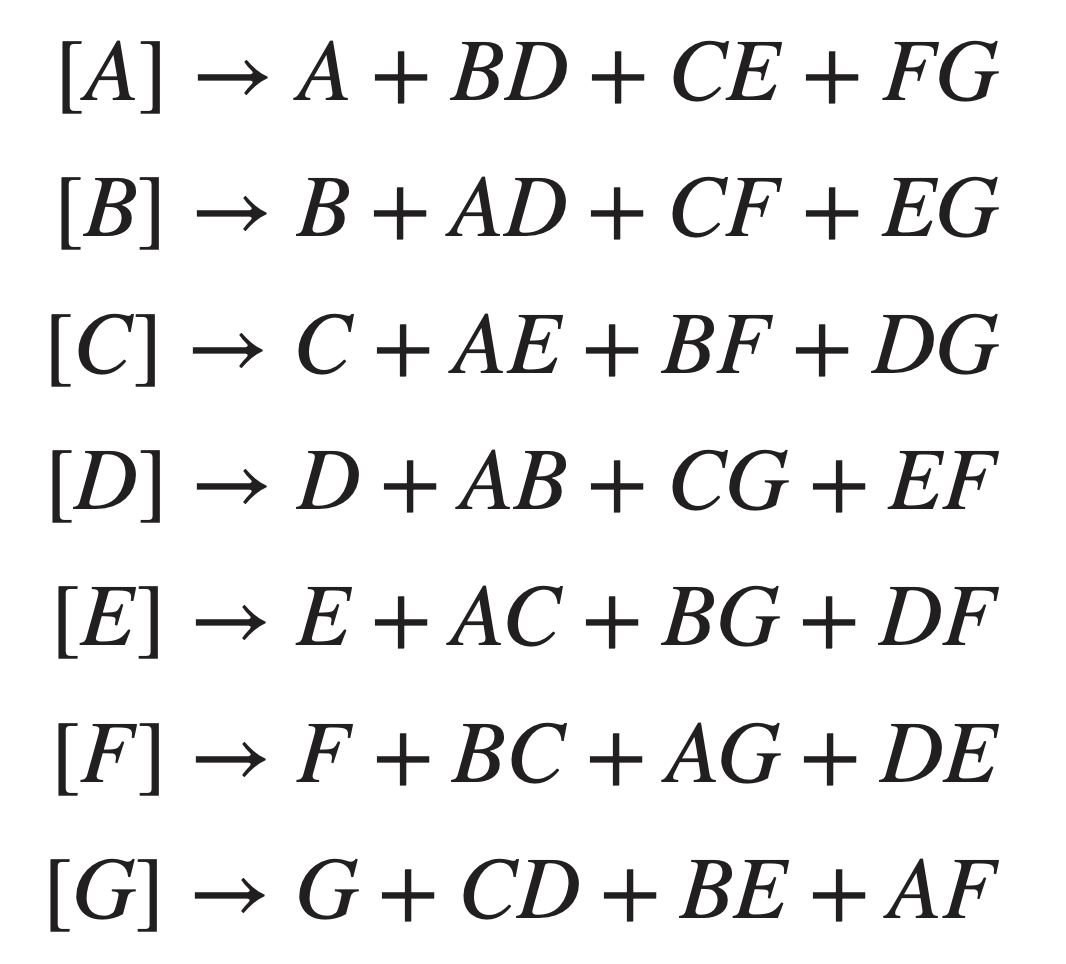
These aliases can be found in Appendix Table
The saturated design
For example, to generate a design for six factors in eight runs, simply drop any one column for example column G. This produces the design shown below
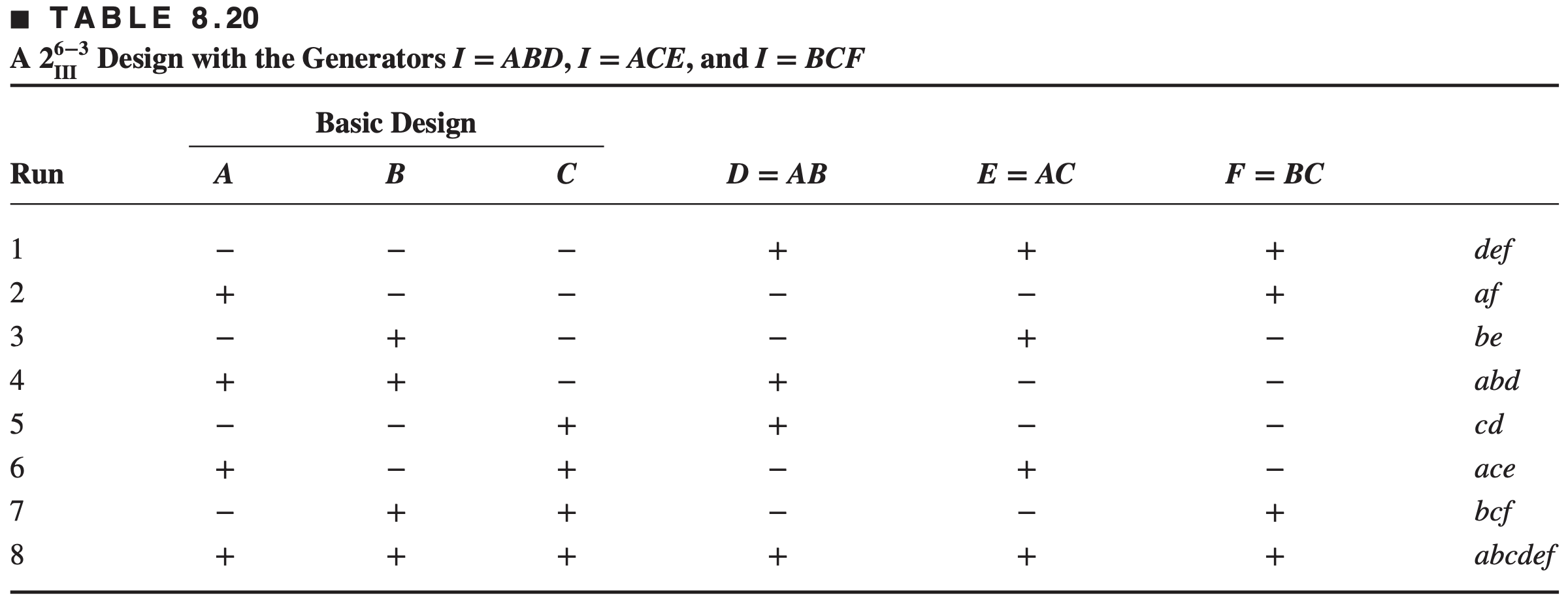
It is easy to verify that this design is also of resolution III; in fact, it is a
The defining relation for the
Thus, the defining relation for our new design is
It is also possible to obtain a resolution III design for studying up to 15 factors in 16 runs.
This saturated
In this design, each of the 15 main effects is aliased with seven two-factor interactions.
A similar procedure can be used for the
8.6.2 Fold Over of Resolution III Fractions to Separate Aliased Effects
Fold Over of Resolution III
By combining fractional factorial designs in which certain signs are switched, we can systematically isolate effects of potential interest.
This type of sequential experiment is called a fold over of the original design
- Consider the
| Run | A | B | C | D=-AB | E=AC | F=BC | G=ABC | Treat. comb. |
|---|---|---|---|---|---|---|---|---|
| 1 | - | - | - | + - | + | + | - | ef |
| 2 | + | - | - | - + | - | + | + | afg |
| 3 | - | + | - | - + | + | - | + | beg |
| 4 | - | - | + | + - | - | - | + | cg |
| 5 | + | + | - | + - | - | - | - | ab |
| 6 | + | - | + | - + | + | - | - | ace |
| 7 | - | + | + | - + | - | + | - | bcf |
| 8 | + | + | + | + - | + | + | + | abcefg |
- The effects that may be estimated from this second fraction are:
Now from the two linear combinations of effects
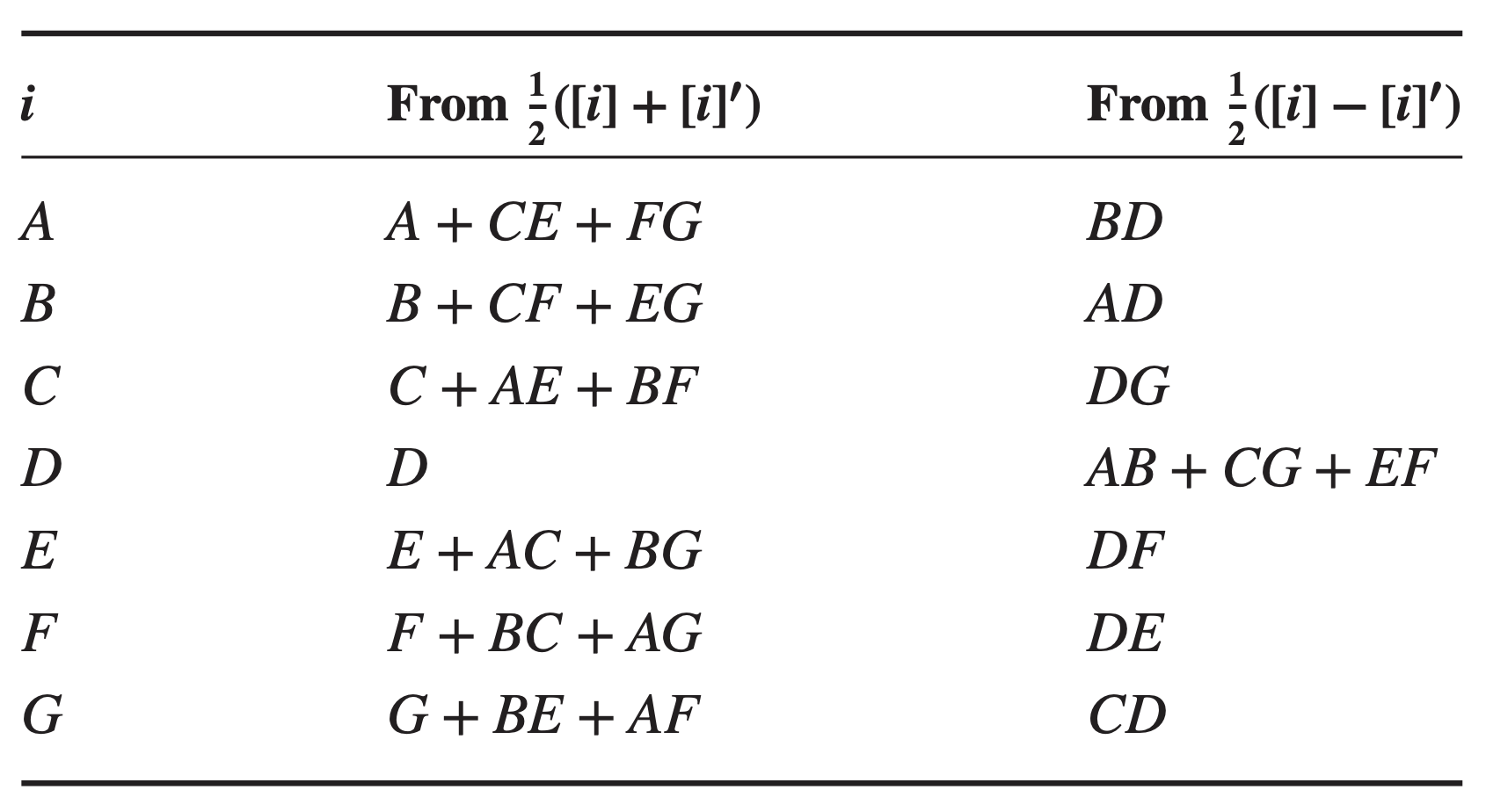
Thus, we have isolated the main effect of
In general, if we add to a fractional design of resolution III or higher a further fraction with the signs of a single factor reversed, then the combined design will provide estimates of the main effect of that factor and all of its two-factor interactions.
This is sometimes called a single-factor fold over.
Now suppose we add to a resolution III fractional a second fraction in which the signs for all the factors are reversed.
This type of fold over (sometimes called a full fold over or a reflection) breaks the alias links between all main effects and their two-factor interactions.
That is, we may use the combined design to estimate all of the main effects clear of any two factor interactions.
Example 8.7: Eye Focus Time Experiment
(illustrates a fold-over technique)
A human performance analyst is conducting an experiment to study eye focus time and has built an apparatus in which several factors can be controlled during the test.
The factors he initially regards as important are acuity or sharpness of vision (
Two levels of each factor are considered. He suspects that only a few of these seven factors are of major importance and that high-order interactions between the factors can be neglected.
On the basis of this assumption, the analyst decides to run a screening experiment to identify the most important factors and then to concentrate further study on those.
To screen these seven factors, he runs the treatment combinations from the
After running the treatment combinations in random order the focus times in milliseconds are shown below
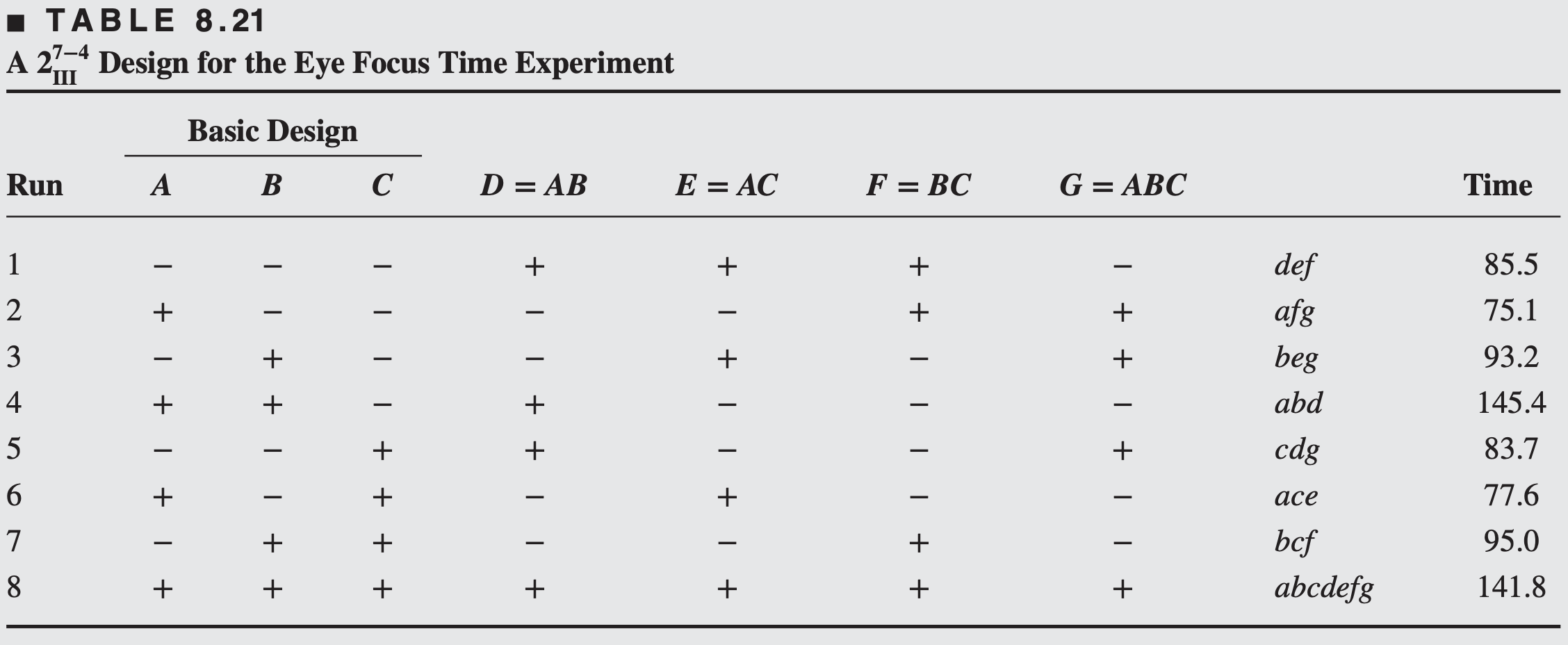
- Seven main effects and their aliases may be estimated from these data. From Equation 8.2, we see that the effects and their aliases are
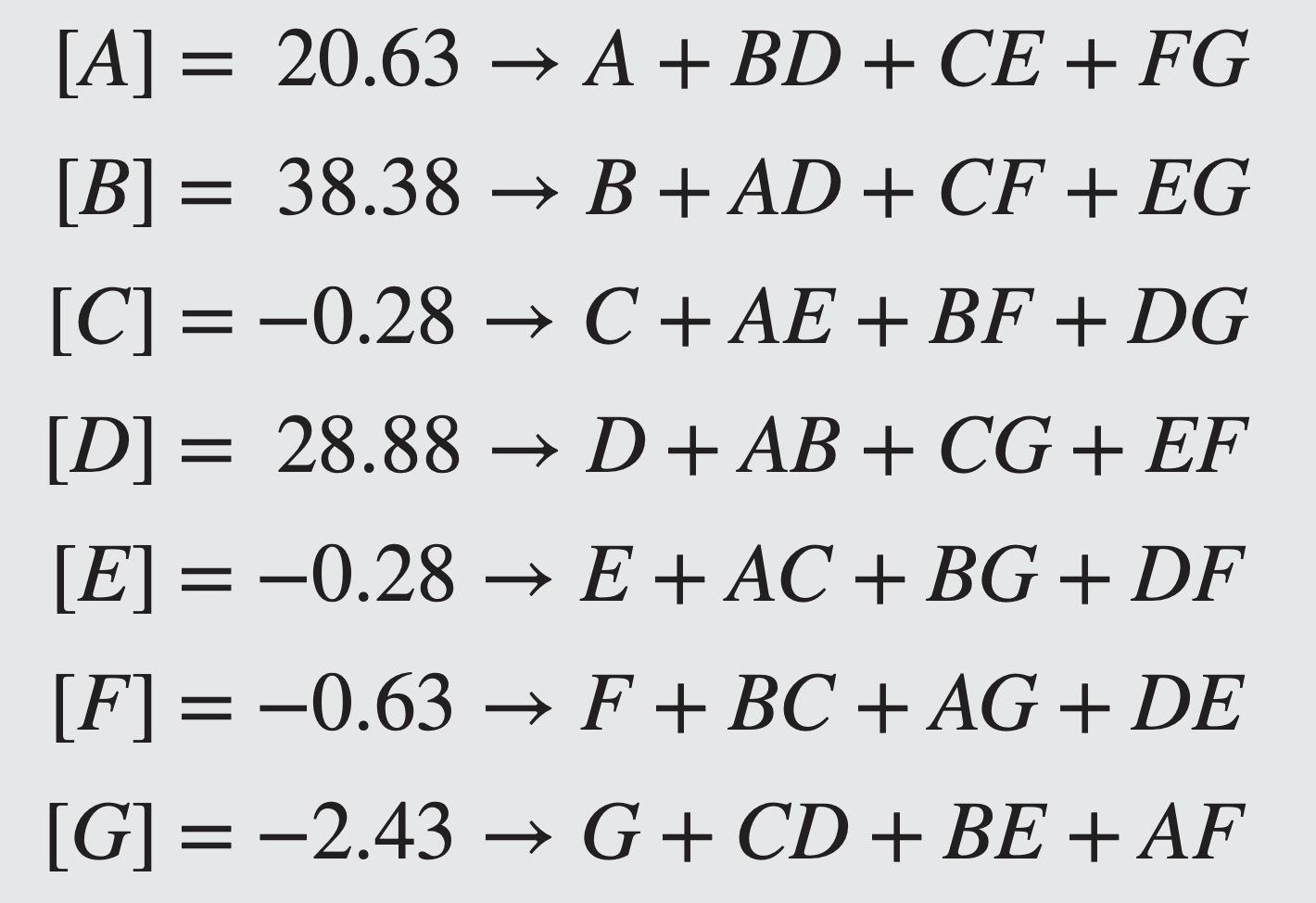
- For example, the estimate of main effect of
The three largest effects are
Could be the main effects of
Or
Or perhaps
Or perhaps
To separate the main effects and the two-factor interactions, the full fold-over technique is used, and a second fraction is run with all the signs reversed.
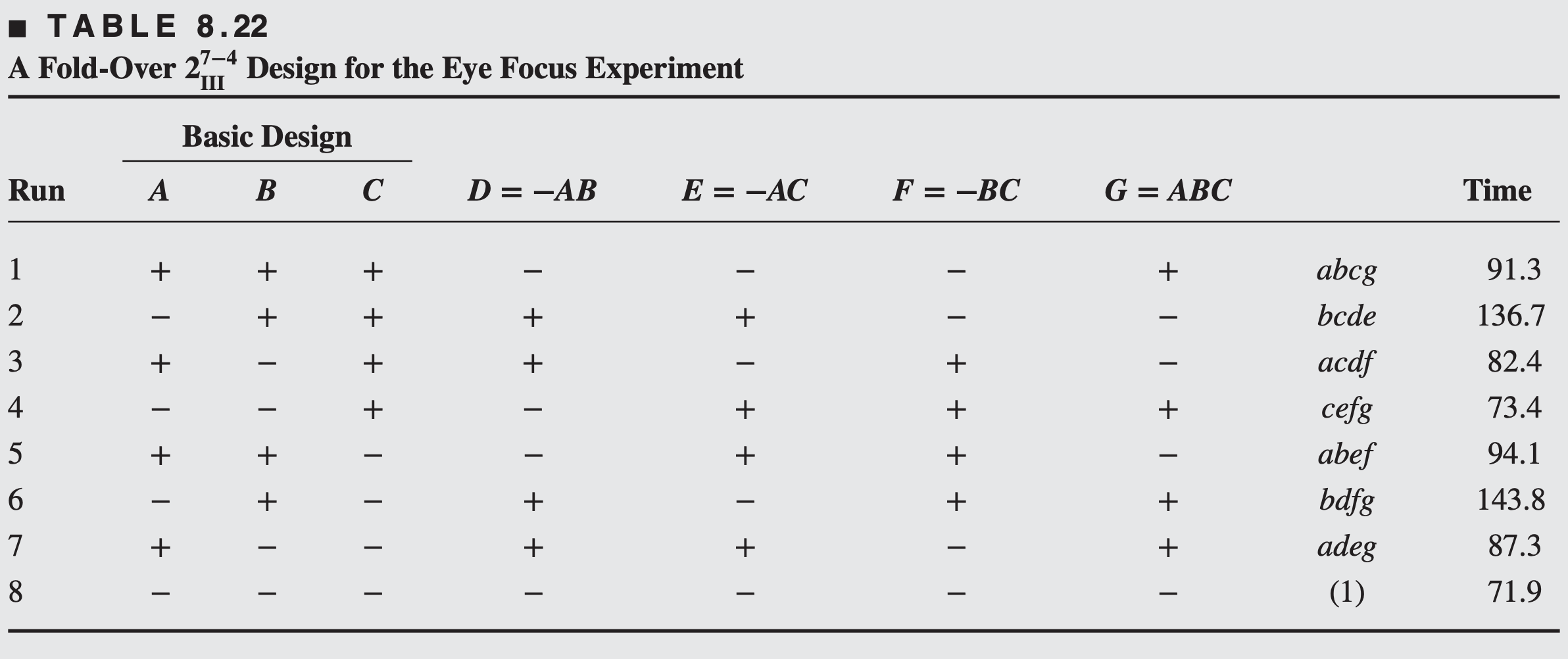
Notice that when we construct a full fold over of a resolution III design, we (in effect) change the signs on the generators that have an odd number of letters. The effects estimated by this fraction are
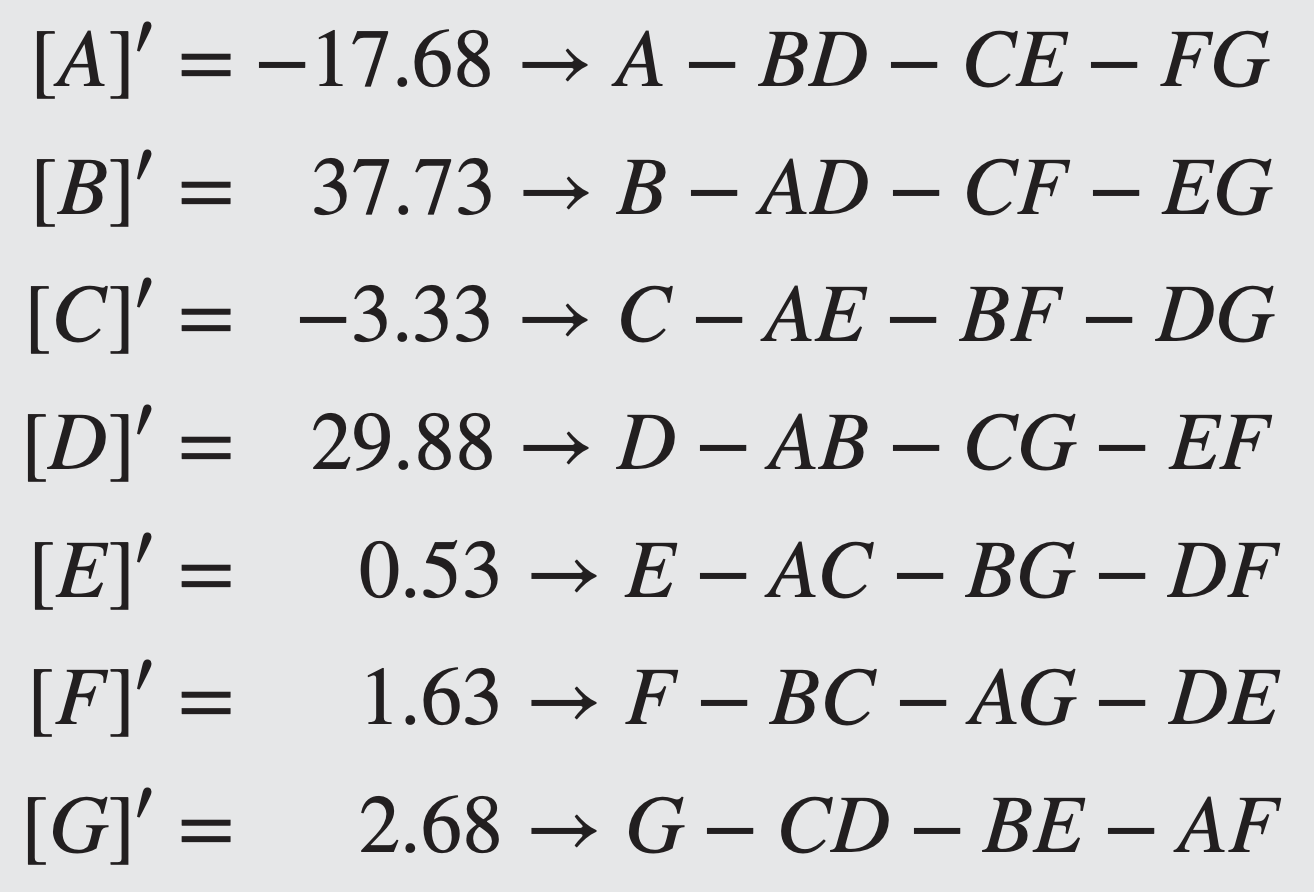
By combining this second fraction with the original one, we obtain the following estimates of the effects:
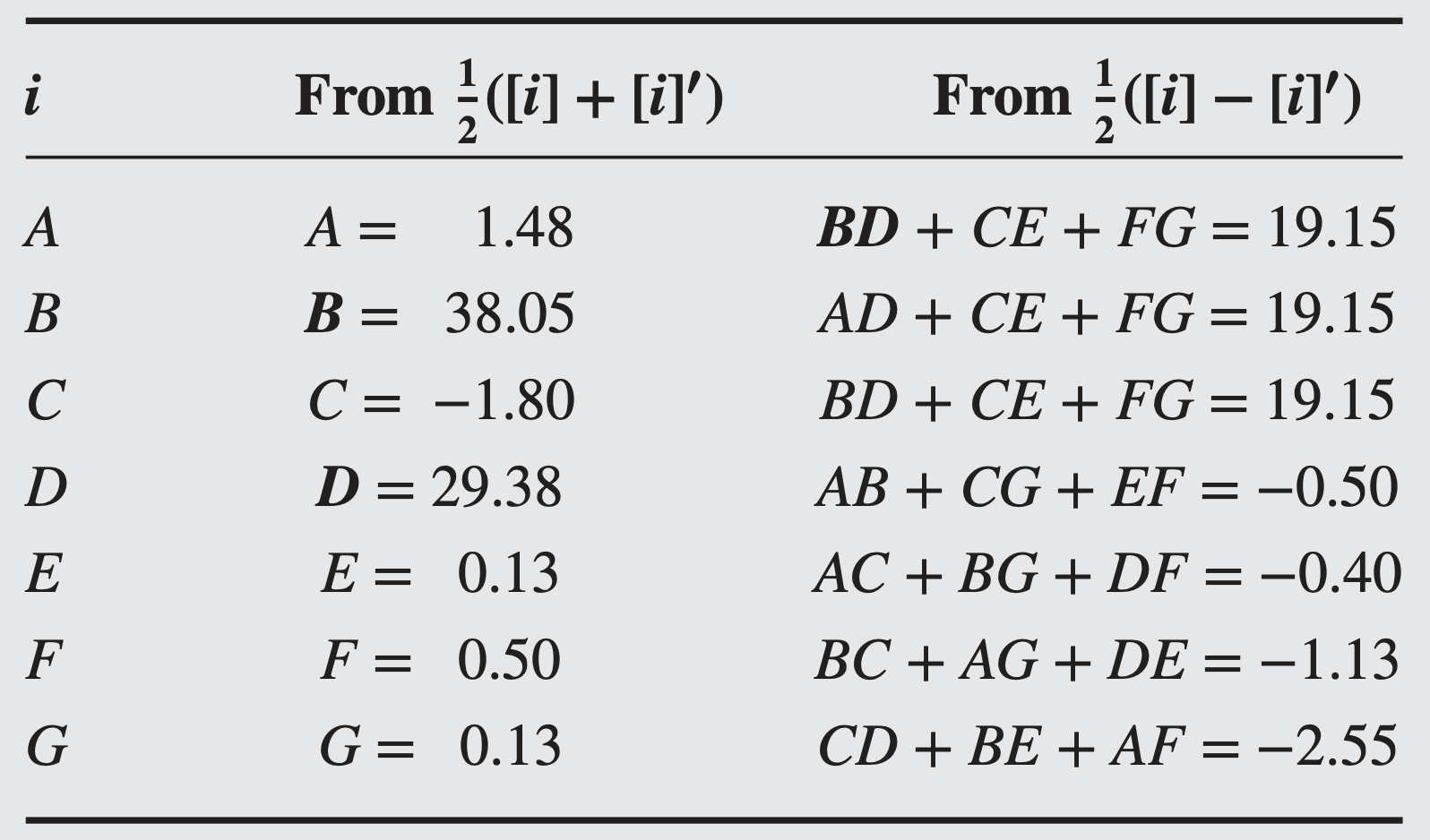
The two largest effects are
The experimenter used the two factors distance
Defining Relation for a Fold-Over Design
It is often of interest to know the defining relation for the combined fractional factorial designs via fold over design.
Each separate fraction will have
The combined design will have
These will be the
Even products are words taken two at a time, four at a time, and so forth.
To illustrate this procedure, consider the design in Example 8.7. For the first fraction, the generators are
and for the second fraction, they are
For example, take
Also, take
The complete defining relation for the combined design is
Blocking in a Fold-Over Design
Usually a fold-over design is conducted in two distinct time periods.
Following the initial fraction, some time usually elapses while the data are analyzed and the fold-over runs are planned.
Then the second set of runs is made, often on a different day, or different shift, or using different operating personnel, or perhaps material from a different source
This leads to a situation where blocking to eliminate potential nuisance effects between the two time periods is of interest.
To illustrate, consider the fold-over experiment in Example 8.7. In the initial group of eight runs the generators are
In the fold-over set of runs, the signs are changed on three of the generators so that
Thus, in the first group of eight runs the signs on the effects
Actually, there is a single-degree-of-freedom alias chain confounded with blocks and the effects in this alias chain may be found by multiplying any one of the effects
In general, a completed fold over experiment will always form two blocks with the effects whose signs are positive in one block and negative in the other (and their aliases) confounded with blocks.
Summary of 8.6.2
Fold over design: Sequential assembly of fractions to separate aliased effects
Switching the signs in one column provides estimates of that factor and all of its two-factor interactions - called single-factor fold-over
Switching the signs in all columns dealiases all main effects from their two factor interaction alias chains - called a full fold-over
Defining relation for a fold-over
Be careful - these rules only work for Resolution III designs
There are other rules for Resolution IV designs, and other methods for adding runs to fractions to dealias effects of interest
8.6.3 Plackett-Burman designs
These are a different class of resolution III design
The fractional factorials we have considered so far are for
In Plackett-Burman designs, the number of runs,
The designs where
Because these designs cannot be represented as cubes, they are sometimes called nongeometric designs
The following table presents rows of plus and minus signs that are used to construct the Plackett– Burman designs for N = 12, 20, 24, and 36.

The designs for
A second column is then generated from this first one by moving the elements of the column down one position and placing the last element in the first position. A third column is produced from the second similarly, and the process is continued until column
The design for N = 12 runs and k = 11 factors is shown below
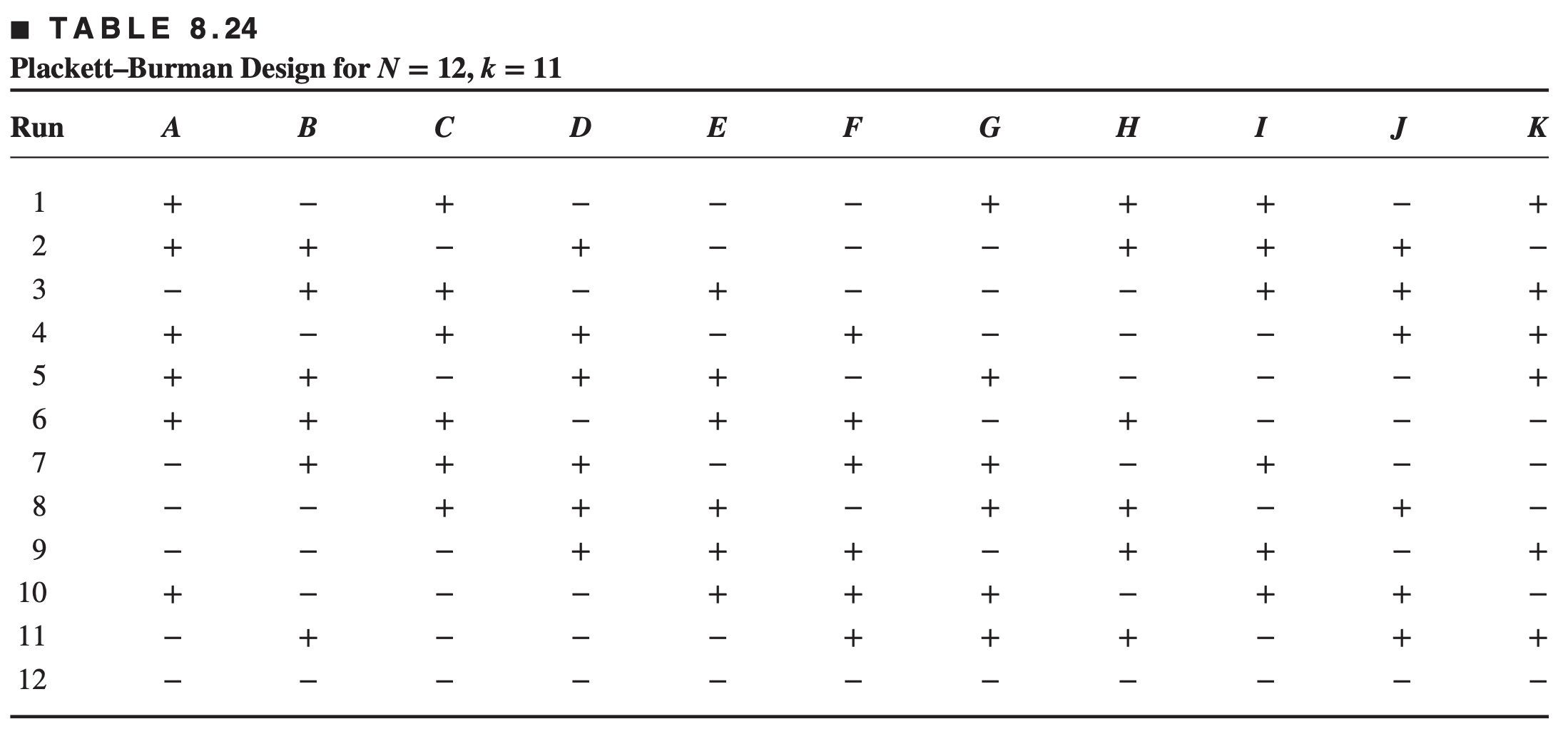
The nongeometric Plackett-Burman designs for
For example, in the 12 -run design every main effect is partially aliased with every two-factor interaction not involving itself.
For example, the
Furthermore, each main effect is partially aliased with 45 two-factor interactions. As an example, consider the aliases of the main effect of factor
Each one of the 45 two-factor interactions in the alias chain in weighed by the constant
This weighting of the two-factor interactions occurs throughout the Plackett–Burman series of nongeometric designs.
In other Plackett–Burman designs, the constant will be different than
8.7 Resolution IV and V Designs
A
Thus, if three-factor and higher interactions are suppressed, the main effects may be estimated directly in a
Resolution IV designs are used extensively as screening experiments. The
Any
Resolution IV designs that contain exactly
To fold over a
Then the plus signs in the identity column
The process is demonstrated below for the
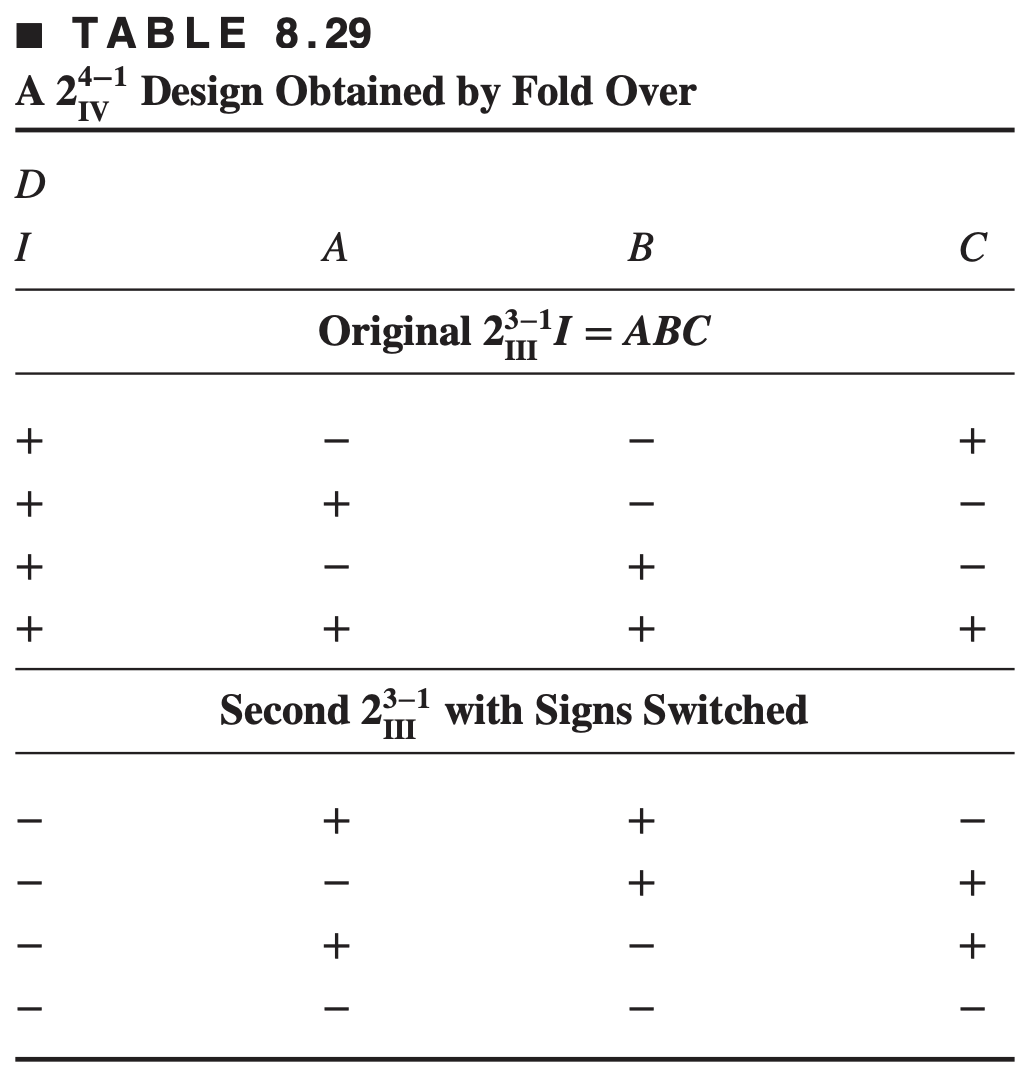
It is easy to verify that the resulting design is a design with defining relation
Table 8.30 provides a convenient summary of
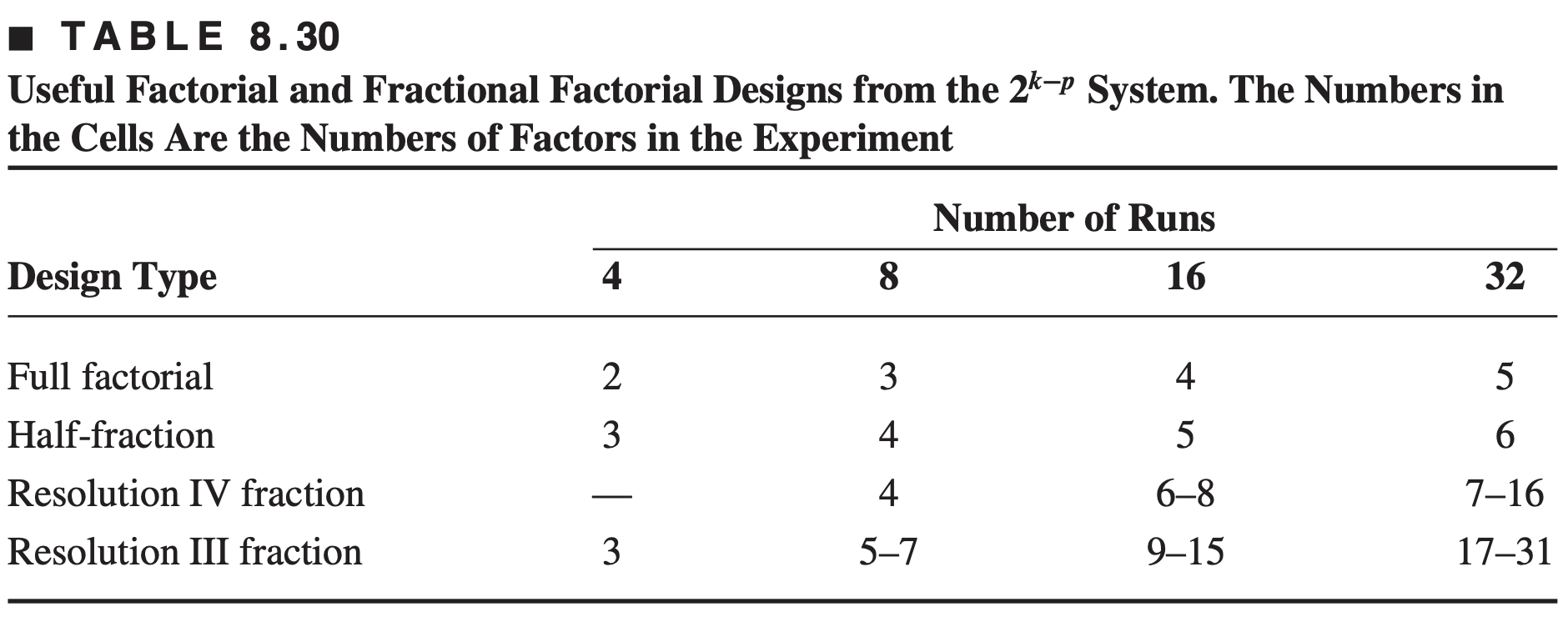
Sequential Experimentation with Resolution IV Designs
Because resolution
It is possible to fold over resolution IV designs to separate two-factor interactions that are aliased with each other.
An experimenter may have several objectives in folding over a resolution IV design, such as
Breaking as many two-factor interaction alias chains as possible,
Breaking the two-factor interactions on a specific alias chain, or
Breaking the two-factor interaction aliases involving a specific factor
However, one has to be careful in folding over a resolution IV design.
The full fold-over rule that we used for resolution III designs, simply run another fraction with all of the signs reversed, will not work for the resolution IV case. If this rule is applied to a resolution IV design, the result will be to produce exactly the same design with the runs in a different order. Try it! Use the
The simplest way to fold over a resolution IV design is to switch the signs on a single variable of the original design matrix. This single-factor fold over allows all the two-factor interactions involving the factor whose signs are switched to be separated and accomplishes the third objective listed above
Example of single fold-over of Resolution IV
To illustrate how a single-factor fold over is accomplished for a resolution IV design, consider the following
An experiment was conducted to study the effects of six factors on the thickness of photo-resist coating applied to a silicon wafer.
The design factors are
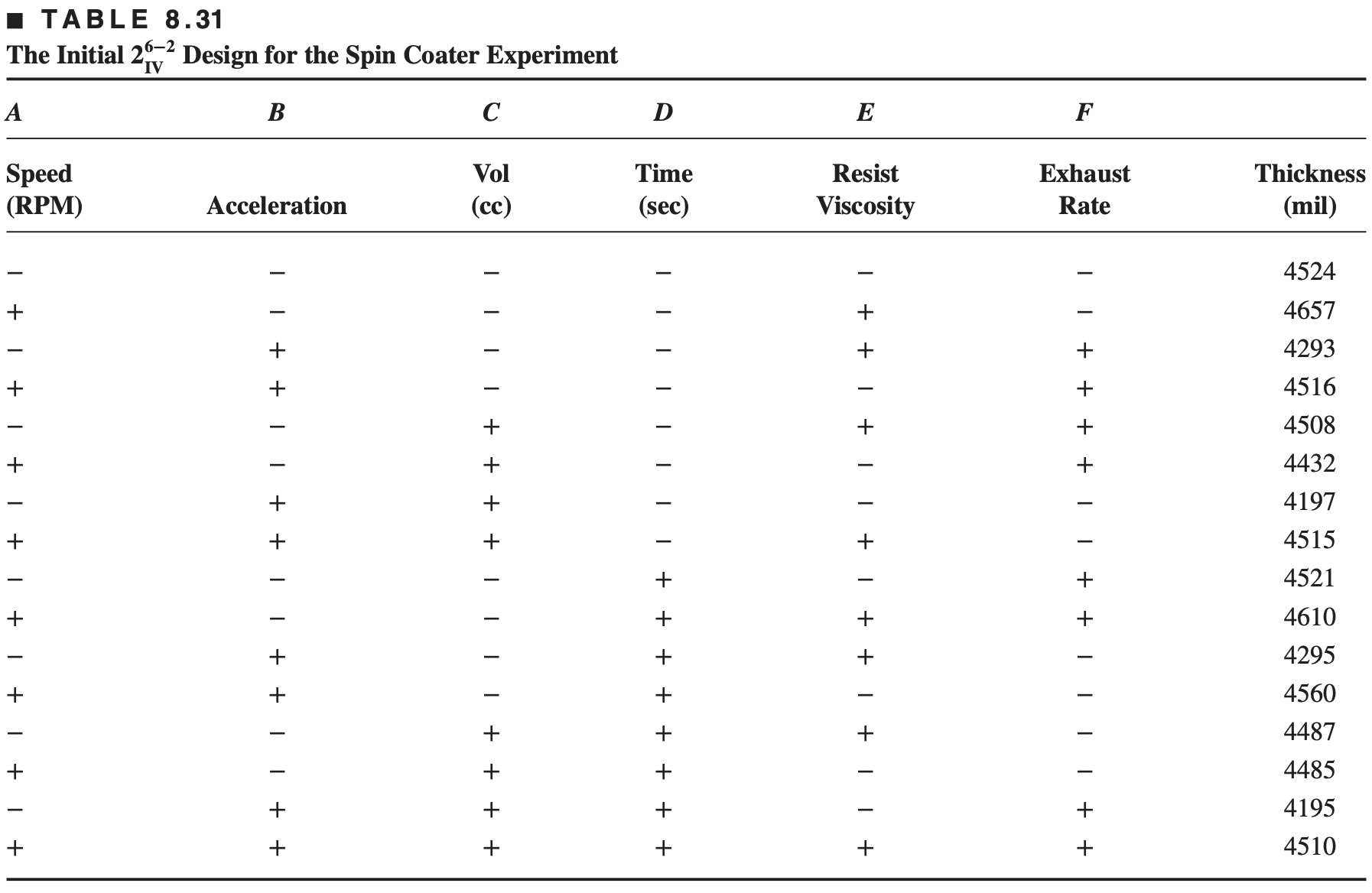
Alias Structure for the

- The half-normal probability plot of the effects is
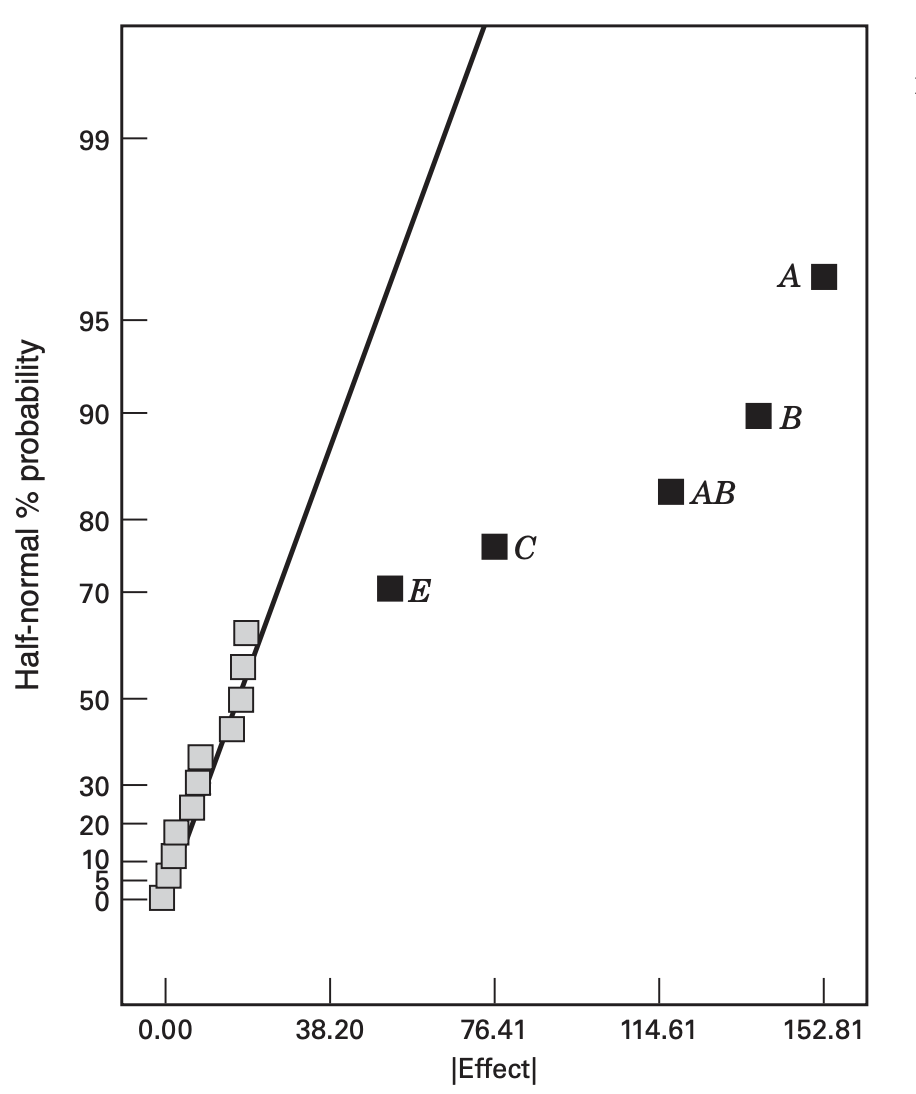
The largest main effects are
However, since
The fold-over design is constructed by setting up a new
The complete design following the addition of the fold-over runs is shown below.
Notice that the runs have been assigned to two blocks; the runs from the initial
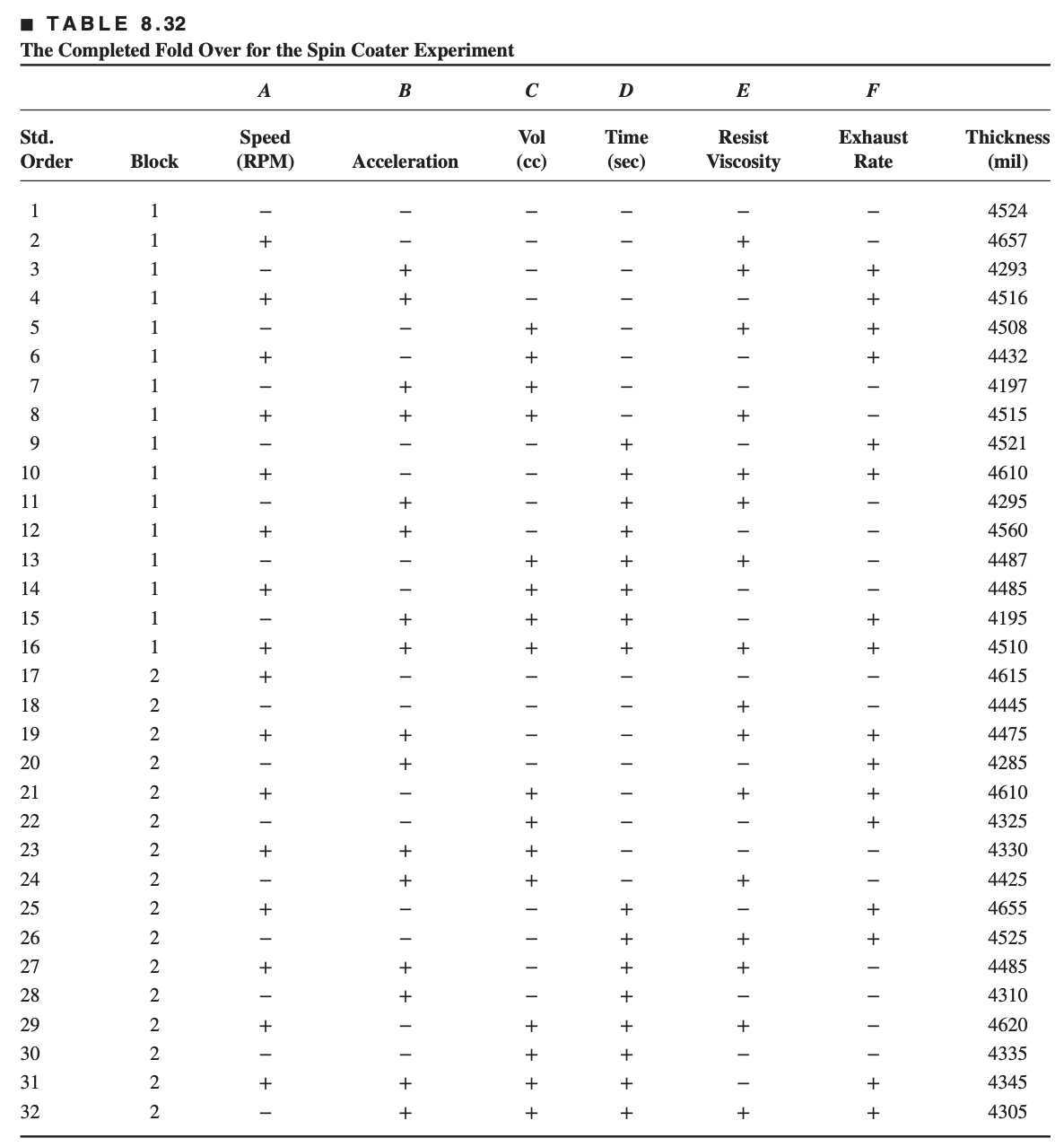
The effects that are estimated from the combined set of runs are (ignoring interactions involving three or more factors)
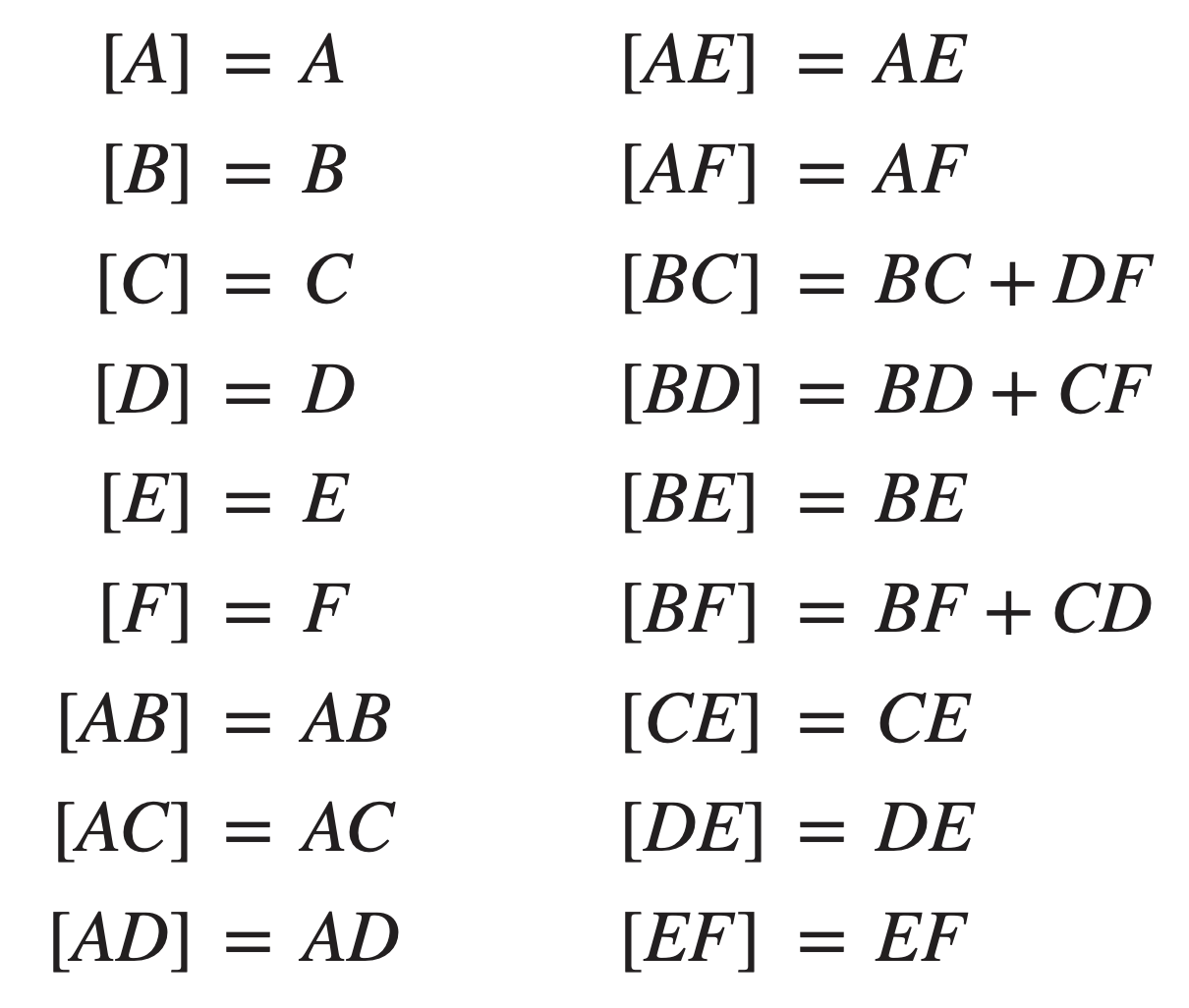
All of the two-factor interactions involving factor
The half-normal probability plot of the effects from the combined design clearly shows the
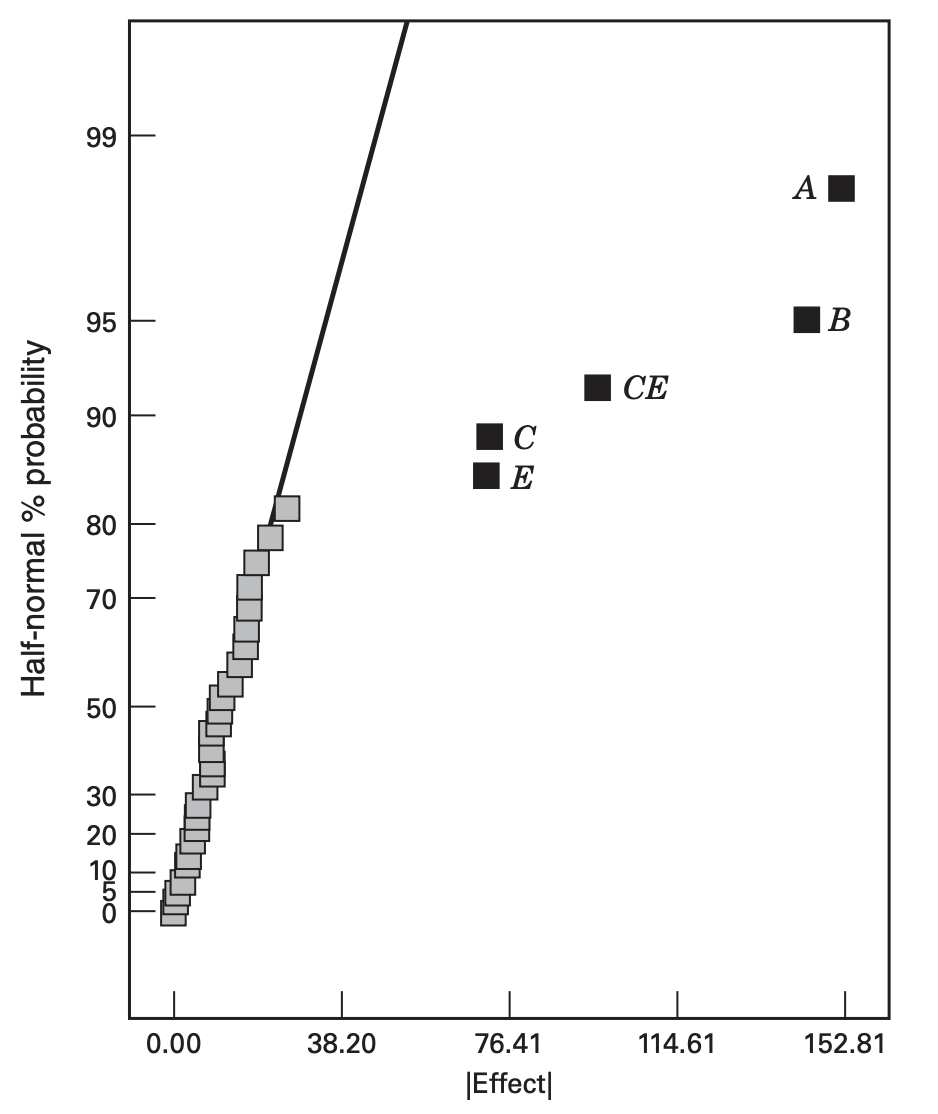
The generators for the original fractions are
Since there is only one word of like sign
Furthermore, since
Full fold over of Resolution IV
A full fold-over of a Resolution IV design is usually not necessary, and it’s potentially very inefficient.
In the spin coater example, there were seven degrees of freedom available to estimate two-factor interaction alias chains.
After adding the fold-over (16 more runs), there are only 12 degrees of freedom available for estimating two-factor interactions (16 new runs yields only five more degrees of freedom).
Resolution V Designs
Resolution
Consequently, these are very powerful designs, allowing unique estimation of all main effects and two-factor interactions, provided of course that all interactions involving three or more factors are negligible.
The shortest word in the defining relation of a resolution
The
Generally, Resolution